Review






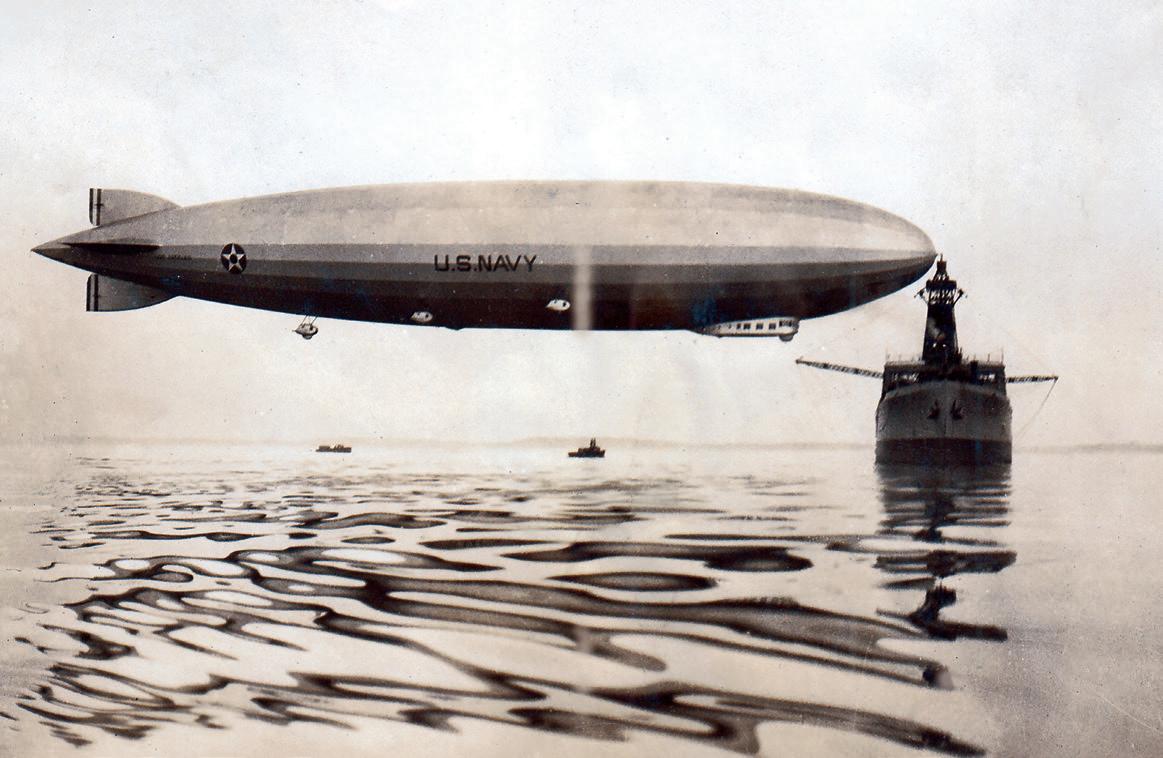

Check out the latest releases as well as the 100+ book titles in the APS publication shop.
http://stamps.org/publications



North Atlantic Non-Contract Steamship Sailings 1838-1875 by Richard Winter and John Barwis. 336 pages. Member price $55 plus shipping.
A sequel to Winter's North Atlantic Mail Sailings 1840-1875, this reference work is essential for postal history research. Containing details of sailing schedules of 54 steamship companies, with illustrations and historical context.
Restocked due to demand.
 U.S. Zeppelin and Airship Mail Flights
Cheryl R. Ganz
U.S. Zeppelin and Airship Mail Flights
U.S. Zeppelin and Airship Mail Flights
Cheryl R. Ganz
U.S. Zeppelin and Airship Mail Flights
94 HOW NORTH ATLANTIC NON-CONTRACT SAILINGS BOOK WAS CREATED, By
Susanna MillsOur editor speaks with John Barwis, co-author of North Atlantic Non-Contract Steamship Sailings 1838-1875 about the creation of this important postal history book. Topics include how the authors compiled existing information and records, tracked down missing information and discovered resources.
101 FROM COLLECTOR TO AUTHOR By
Rick BarrettRick Barrett simply wanted to share his interest via a booklet about the cinderella stamps created for the 1901 Pan American Exposition in Buffalo. After several years of research, Barrett created an award-winning book on the stamps. Here, he explains how it all happened.
114 A CURIOUS SKIT By
Abhishek BhuwalkaThe author stumbled upon an intriguing journal that published a single edition of about 10 copies in 1905. The author visited the British Library to check out this rarity. What did he find? A “skit” (parody) of a stamp journal.
121 HOW TO RESEARCH THROUGH THE APRL By
Paul WeidhaasThe author collects match and medicines revenue stamps; M&Ms for short. He found great value in researching his area at the American Philatelic Research Library. He shares his research methods.
127 STAMPS AS COFFEE TABLE ART By
David Cobb CraigThe author built a collection of 122 U.S. stamps issued between 1957 and 1977 with a great appreciation for color, design and message. When a photographer friend suggested the bold beauty of the stamps would make a great book, the pair collaborated.
85 REMEMBRANCE, Staff report
The American Philatelic Research Library sadly lost one of its greatest supporters earlier this year when Dr. Kenneth (Ken) B. Grant, passed away. Grant – referred by many as “dedicated, steady and thoughtful,” served many years as an officer for the APRL.
JOURNAL OF THE AMERICAN PHILATELIC RESEARCH LIBRARY VOL.
279 SECOND QUARTER 2023
100 Match Factory Place Bellefonte, PA 16823
Phone: 814-933-3803
Fax: 814-933-6128 plrarticle@stamps.org
ADMINISTRATOR & PUBLISHER
Scott D. English • scott@stamps.org
EDITOR-IN-CHIEF
Susanna Mills • smills@stamps.org
SENIOR EDITOR
Jeff Stage • jstage@stamps.org
GRAPHIC COMMUNICATIONS SPECIALIST
Chad Cowder • ccowder@stamps.org
ASSOCIATE EDITOR, LIBRARIAN & DIRECTOR OF INFORMATION SERVICES
Scott Tiffney • stiffney@stamps.org
ADVERTISING SALES
Steve Schwanz
Fox Associates, Inc. 800-345-8670 x 114 adinfo.theamericanphilatelist@foxrep.com
©American Philatelic Research Library, 2023
Philatelic Literature Review (USPS 928-660, ISSN0270-1707) is published quarterly by the American Philatelic Research Library, Inc. (APRL). Telephone: 814-933-3803; Fax: 814-933-6128; E-mail: plr@ stamps.org; Website: www.StampLibrary.org.
Postmaster: send address changes to the APRL, 100 Match Factory Place, Bellefonte, PA 16823. Periodicals postage paid at Bellefonte, PA 16823, and additional entry offices.
Annual subscription rates: $21, regular members; $30, sustaining members; and $50, contributing members. Libraries and institutions, $30. Single copy price, $5.


Ever since I became active in organized philately, I was hoping to make the hobby accessible to many different people, regardless of their geographic locations, income levels or formal educational attainments. There are so many different paths to pursue in philately and postal history –each participant can tailor it to suit their interests. So, as a trained journalist, when I learned about how active writers and editors have been, I was excited.
Not only have hobbyists written about their areas of interest for decades, but they have shared this knowledge through a variety of publications, both online and print. Taking it a step further, they created, operated and participated in formal competitions called literature
competitions. I found this remarkable.

Just as there are essay contests for youth and formal prizes for professional writers, organized philately offers awards for what judges deem the best writing within a given timeframe such as the past year. Two notable (and annual) literature competitions in the U.S. are held at the Chicagopex stamp show and the Great American Stamp Show. Each features trained judges who evaluate a range of publication types, including articles, books, journals, websites and more.
If you are a writer or editor for a local publication, or one specializing in a

certain topic or country, I urge you to consider entering a literature competition. I know it can take a great deal of research and effort to put together a well-written article or book. By entering such a competition, you get an opportunity to be recognized for your work. It is also a chance to obtain some publicity for your entry.
Further, judges usually will provide detailed feedback on why they rated the work the way they did. This can prove invaluable – it is an opportunity to improve – especially when the judge has been active for many years or is award-winning in their own right. At the competitions I mentioned earlier, the judges hold a live feedback session, where attendees can hear not only feedback about their own entries but about works entered by others, too.
Even if you are not a writer yourself, you can explore literature competitions for your own benefit. How? Look at the publications and websites that have been entered. Contact the APRL to obtain a scan or check out the book. You may become aware of a publication in your area of interest – or you can look at it to get an idea of how to approach writing about your own specialty. For exhibitors, reviewing the entry lists from literature competitions can give them some ideas for research to support their exhibits.
For me, it has been easier to write articles and submit them to literature competitions and receive medals and ribbons than it has to become an exhibitor. This has also helped me to feel I could actively participate in the hobby and the related awards ceremonies and banquets.
Having awareness of literature competitions is also a nice way to be able to give kudos to fellow collectors.
If you read a list of the awards and recognize a name, I encourage you to offer congratulations to that person. In several instances, I mentioned seeing someone’s award to them, and they were surprised I noticed. It may seem like a minor thing, but most people like to be recognized, especially if it is for something they have worked hard on or care a lot about.
The literature entered into such competitions lives on, too. In the case of Chicagopex, the entries are given to the Collectors Club of Chicago library upon the conclusion of the stamp show. This ensures they remain accessible to collectors across the Midwest. The entries from GASS are retained by the APRL, which ensures a similar outcome.
Over the past few decades, exhibitors have had an opportunity to scan their exhibits and donate the digital scans to the APRL or specialty societies – this is a great way to ensure exhibits live on, even if they are later sold or physically taken apart. APRL’s digital library effort provides a

PRESIDENT
Melanie G. Rogers
VICE-PRESIDENT
Thomas Bieniosek
SECRETARY
Charles Epting
TREASURER
Kathryn Johnson
TRUSTEES
Hugh McMackin
Casey Jo White
Rich Drews
Murray Abramson
Jean Wang
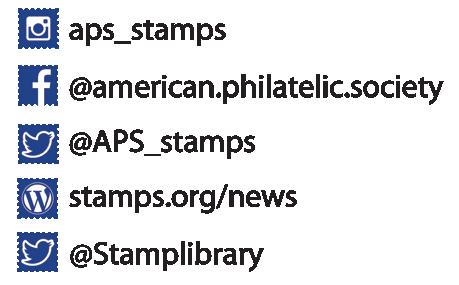
similar opportunity for e-copies of articles, books and journals whose authors / custodians have given permission.
Curious which publications have won accolades in prior competitions? You can look online for past lists of competition winners (formally Palmares). The APRL team can also assist in pulling historical lists. Chicagopex.org also has postings for the past nine or so years.
As many of you know, this year’s Great American Stamp Show will take place August 10-13 in Cleveland, Ohio. And while all of the show's hotel rooms are already booked, you should still be able to reserve one not too far away. If you are able to join us, I encourage you to visit the booth for the literature competition and see what has been entered. If you look in the show program,
you can find out when the judges’ feedback session takes place and make time to attend. I am also pleased to share the Collectors Club of Chicago is sponsoring the GASS literature competition again this year. And the grand award is usually announced at the Saturday night awards banquet.
Finally, I would like you to consider writing about your area of interest. The hobby needs a diversity of voices. You do not have to be a trained writer nor do you have to write a book. This PLR has a section of book reviews at the back; did you read a philatelic book you would like to share thoughts on? Even a few paragraphs about your favorite cover will likely be welcomed by one of the many publications that cater to stamp collectors and postal historians.
Ad Sizes: Full Page • Half Page • Quarter Page
Ad Deadlines: 3rd Quarter, July 17
4th Quarter, October 17
Contact Steve Schwanz, Fox Associates, Inc. for 2022 advertising rates. See below contact information.
Display advertisers will be invoiced upon publication of their ads.
Dealer Directory Listing in the 1st and 3rd Quarter issues is FREE to advertisers who have a display ad in these issues, otherwise there is a $25 listing fee.
Clearinghouse Ad Rates: $3 per listing with a maximum of 10 items per submission. Items selling for greater than $100 are $7 per listing. Payment MUST accompany all Clearinghouse ads.
For information: Steve Schwanz, Fox Associates, Inc.
Phone: 800-440-0231 x114
E-mail: adinfo.theamericanphilatelist@foxrep.com

In the May issue of The American Philatelist, we reported on leadership changes on the APS Board of Directors. One of those changes included Greg Galletti being appointed vice president and resigning as vice president of the American Philatelic Research Library Board of Trustees.
In April, the APRL Board of Trustees convened and elected Tom Bieniosek to serve as vice president through the remainder of the 2022-2025 term. Tom was elected to the Board of Trustees in 2019. He is active in the local philatelic community, serving as president of the Medina County Stamp Club and past president of the Collectors Club of Akron. His collecting interests include Poland, Bolivia, Argentina, and German Colonies. Tom serves on the APS Expert Committee and has been a regular instructor at the annual APS Summer Seminar. We also welcome Tom and his wife, Laurie, to Volunteer Work Week annually. Please join me in thanking Tom for all his contributions to the APS and APRL, and congratulations on his new role as Vice President of the APRL Board of Trustees.
Joining the APRL Board is Dr. Jean Wang, who will fill Galletti’s unexpired term through 2025 as a Trustee. Jean lives in Toronto, Ontario, and is our first Canadian resident to serve on the APRL


Board. She is an active thematic collector and exhibitor, most notably of a five-frame grand award-winning exhibit on blood. Jean has written extensively on medical philately, publishing articles in The Canadian Philatelist and Topical Time.
Jean’s philatelic activities include being membership secretary, now membership director of the Philatelic Specialists Society of Canada, and serving as editor of the annual journal. She is the Royal Philatelic Society Canada delegate to the Fédération Internationale de Philatélie’s Thematic Commission and a member of the board of directors of the Vincent Graves Greene Philatelic Research Foundation. Since 2018, Jean has been a member of Canada Post’s Stamp Advisory Committee. The APS recognized Jean with the Nicholas G. Carter Volunteer Award in 2022, and will present it to her at the Great American Stamp Show in Cleveland.
Last month, we shared the news that former APRL President and APS Secretary Ken Grant passed after a battle with cancer. During Ken’s tenures with the APRL and APS, he advocated for the library’s financial stability through operations and fundraising. At the last APRL meeting that Ken presided over as president, the APRL Board approved merging all the foundation funds to build a more robust fundraising campaign. The proposal brought together those who participated in the legacy Founders and Patrons funds with the newer Vooys Fellows program, started in 2008, to honor Daniel Vooys. In the past three years, we’ve increased the number of Vooys Fellows, nearly doubling the number contributing to the APRL Fund to provide annual funding to the library.
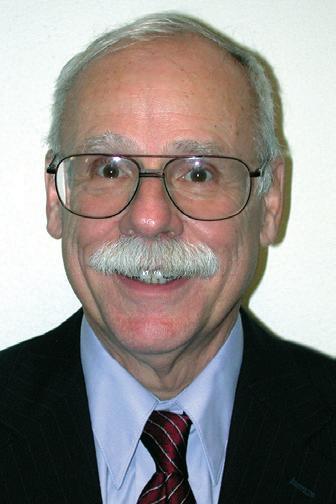 Ken Grant
Ken Grant
To build on that legacy, the APRL Board will create a third tier for those to encourage higher donations to the APRL Fund while honoring Ken’s legacy. Today, donors can make a $1,000 donation to become a Patron and a $5,000 donation to become a Vooys Fellow. Ken was on his way to completing his Vooys pledge before passing in March.
Though the APRL voted to recognize Ken as a Vooys Fellow, APRL Trustee Richard Drews contributed the remaining $2,500 on Ken’s pledge to make it whole. Rich and APS member Michael Turrini are the inaugural donors to the fund honoring Ken Grant. I will present a final proposal to the APRL Board in August. We’ll begin promoting this opportunity to honor Ken and his vision for a sustainable library fund. For those interested, you can contact me directly at scott@stamps.org to join the effort.
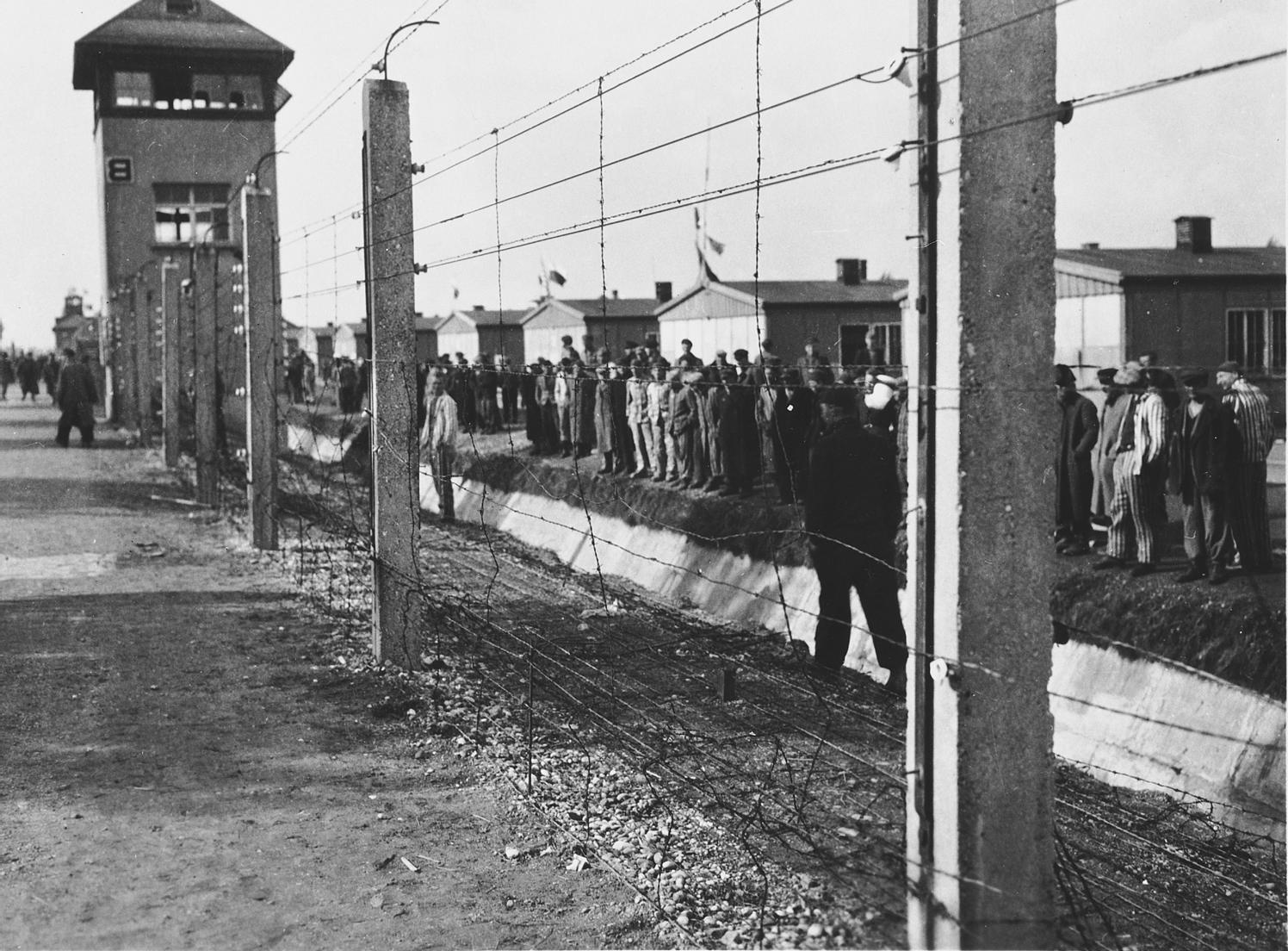
The American Philatelic Society and American Philatelic Research Library sadly report the loss of Dr. Kenneth (Ken) B. Grant, former president of the APRL and secretary of the APS. Ken joined the APS in 1982 and would have celebrated his 40th year at the end of April.
Ken Grant made a lifelong, sustained, and dedicated contribution to the organizational backbone of philately. From his lifetime leadership of the local club in Baraboo, Wisconsin, to his steady and thoughtful leadership at various levels of the APS and APRL, Ken was nothing if not reliable. One of the best examples is Ken’s willingness to step into the presidency for the American Philatelic Research Library to fill a vacancy created by a sudden resignation in 2018. He did so without hesitation. His leadership of the APRL allowed the library to continue its mission to philatelists without interruption.

efforts were recognized when he was awarded the 2020 John N. Luff Award for Outstanding Service to the APS.
“Ken Grant leaves a legacy of remarkable leadership, having led the APRL in challenging times to great success.” said APRL President Melanie Rogers, “I will miss his insights and our conversations. May he rest in peace.”
Ken demonstrated tremendous dedication to the APS and its missions. Besides this significant support of the APS and APRL, Ken faithfully served on the APRL Board of Trustees since 1999, with only a brief gap from this responsibility from 2011 to 2016, when he served as the APS Board secretary. He sat on multiple APS and APRL committees, including the USSS-Mueller Award committee, the Charles Peterson Award committee, Strategic Planning Committee, and more. His tireless
One of Ken’s best accomplishments involves the American Philatelic Center in Bellefonte, Pennsylvania. He was one of the leaders who signed the initial paperwork to purchase the Match Factory and was a part of the decision-making process for every phase of construction up to its completion in 2016. During his most recent tenure as APRL president, the APRL paid off its mortgage debt on the Match Factory in 2020, 15 years ahead of schedule.
“Ken was a true supporter, champion, and friend of the library. On a professional and personal level, Ken was insightful, supportive, and enthusiastic,” Scott Tiffney, director of information services and librarian, said, “We shared a love of books and the information

they provided. It was an honor to work together to provide greater access for our patrons to the resources of the APRL.”
Ken was also a proud supporter of the Campaign for Philately from its inception and served on the committee consistently, with only a gap of two years. The Campaign for Philately, with its goals of serving the needs of current members, supporting new and future collectors, and promoting the hobby, was well-served by Ken’s efforts toward the future of philately.
When Ken was not working on behalf of the APS, he remained highly dedicated to his local stamp clubs and edited the Cinderella Stamp Club’s publication, The Cinderella Philatelist. At the end of Ken’s term as APRL president, the APRL Board of Trustees and others donated to name the library’s cinderella collection in his honor.
About the Dr. Kenneth B. Grant Cinderella Collection

Housed on the library’s first floor, the Dr. Kenneth B. Grant Cinderella Collection consists of four shelves of worldwide cinderella research material. It includes material for both the beginner collector and the experienced philatelist, highlighted by the introductory work Cinderella Stamps, by L.N. and M. Williams, and the comprehensive multi-volume Drummond’s Catalog of Philatelic Miscellany. The collection exemplifies the broad range of interest and research dedicated to this unique facet of philately.
“To build up a library is to create a life. It’s never just a random collection of books.”
– Carlos María Domínguez
Bellefonte, PA
Contact: Scott Tiffney
stiffney@stamps.org
The second quarter of the year ushered in a number of annual events that will involve the library.
First up is Summer Seminar (June 1215), which is a busy time in the library as attendees and instructors make regular use of the library and its resources before, after and sometimes during classes. Staff will be busy that week assisting patrons with all their research needs. It’s always a welcome time to see the library full and students and instructors sharing
their philatelic knowledge.
The second annual event that we look forward to is Volunteer Work Week (July 17-21). Each year a number of regulars as well as new volunteers help us in the library with projects that we either haven’t been able to get to or just need a number of people to help us with. This year we have projects like continued processing of the Trenchard donation and other donations, cleanup of the Archives area, used book repurposing, article indexing and many more. If interested in participating in this year’s Volunteer Work Week (VWW) go the VWW page on the APS website to register (https://stamps. org/learn/volunteer-work-week) or con-
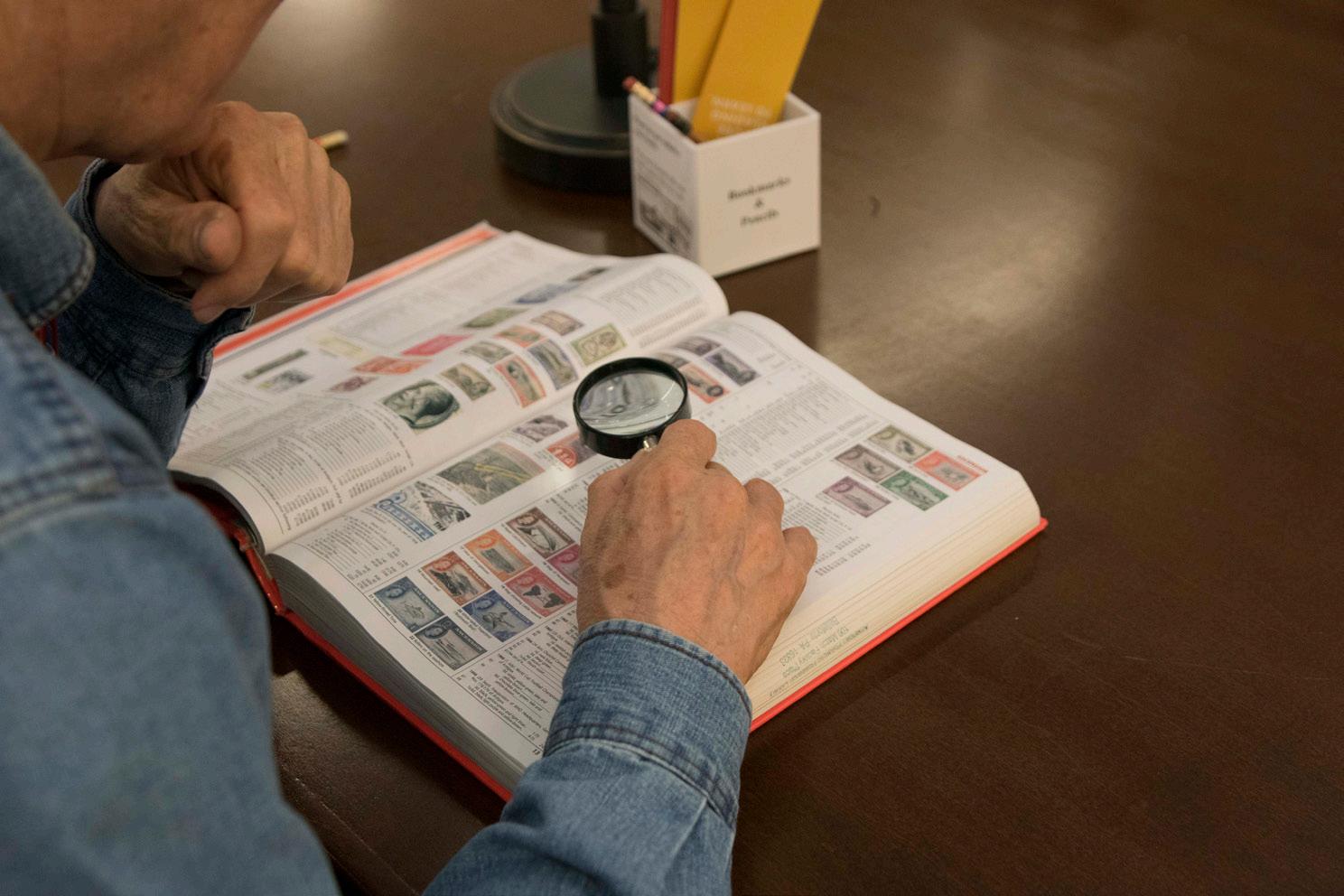
tact the Education department at education @stamps.org.
Finally, a brief update on the progress of the Robert A. Mason Digital Library. We recently surpassed 7,000 journal issues uploaded, more than doubling the issues in the database since starting Phase I of the project in March 2022. We have also increased the journal titles in the database from 12 initially to currently 45 titles, the latest being First Days (American First Day Cover Society) and Forerunners (Philatelic Society for Greater South Africa).
Washington, D.C.
Contact: Baasil Wilder WilderB@si.edu
The NPM Library Research Center (LRC) has recently digitized the 1916 book, Sketches and Reminiscences from Queensland, Russia, and Elsewhere, by H. Ling Roth. It is 40 pages long, with seven detailed plates and found at https:// library.si.edu/digital-library/book/ sketchesreminisc00roth. Written by pro-
lific author Henry Ling Roth, the book covers three countries: Russia, Australia, and Guyana.
The library has welcomed the new head of curatorial affairs, Carrie Villar, whose office will be inside of the NPM Library along with the rest of the museum’s curatorial department.
Carrie has been a senior museum professional for more than 20 years and most recently served as the John and Neville Bryan Senior Director of Museum Collections at the National Trust for Historic Preservation. In this role, Carrie managed the National Trust’s Museum collections, which includes historic buildings, landscapes and more than 60,000 objects. At the National Trust she has also served as the acting vice president for historic sites, as well as the interim executive director of the Woodrow Wilson House.
Prior to that, Carrie served as senior curator at The History Factory in Washington, D.C., where she was the creative lead on teams that worked with a diverse range of corporate and nonprofit clients, including the Los Angeles Unified School District, Whirlpool Corporation, Weight Watchers International, Edward Jones, Boston Scientific and many others. Deliverables for these clients ranged from oral history programs to corporate museums and exhibits to history-based social media platforms.
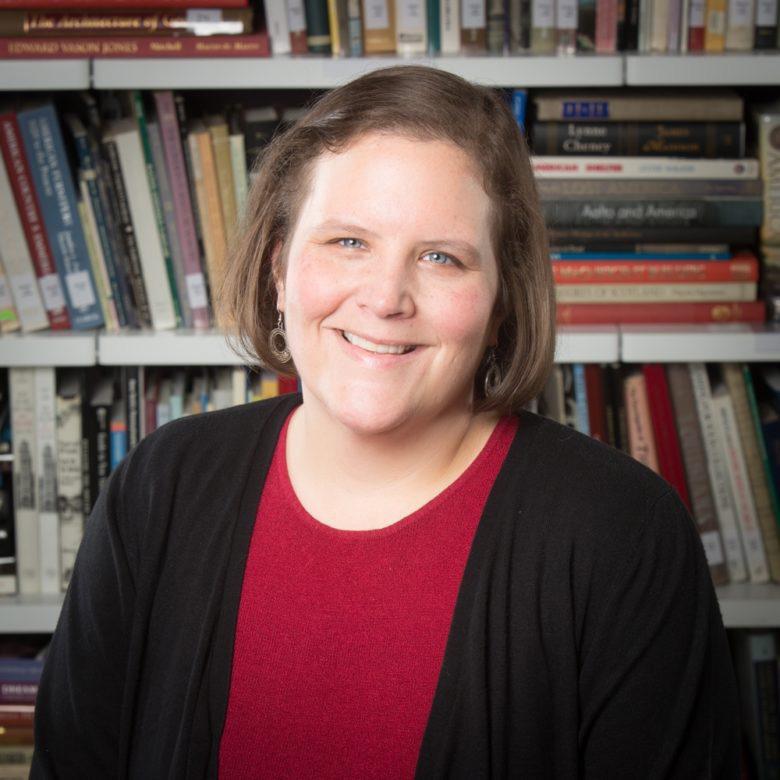
Carrie holds her Master of Arts in history with a Museum Studies Certificate from the University of Delaware, where she received a Hagley Fellowship in the History of Technology and Industrialization. She also earned a Nonprofit Management Executive Certificate from Georgetown University in 2016 and attended the American

Express Leadership Academy in 2018. Carrie lives in Maryland and has extensive experience in many other facets of the museum industry. She has been a board member on the Montgomery County Library Advisory Board and was also a peer reviewer at the Institute of Museum and Library Services.
Denver, CO
Contact: Sherri Jennings
rmpllibrarian1@gmail.com
The shelves are easier to read now. Volunteers picked out the books whose titles cannot be read. They’re placing the titles on the spines of books so that our patrons can find what they’re looking for. The shelves are beautiful now.
The library will begin an inventory soon. Some books are missing in our card catalog, but on the shelves, and some are in the card catalog, but missing from the
shelves. It will all be straight soon.
The library’s philatelic sales area has expanded as it received more and more stamps that can be sold to members. The stock includes worldwide and U.S. stamps, covers, topicals, cinderellas, and postcards. Something for everyone.
The library will celebrate its 30th anniversary on August 26. There will be an open house with hors d’oeuvres, desserts, and wine. This will be a chance for folks to see the buildings and improvements. All members are encouraged to attend
Scandinavian Collectors Club Library
Denver, CO
Contact: Roger Cichorz
rcichorz@comcast.net
The Scandinavian Collectors Club Library (SCCL) is open to SCC members at its location within the Rocky Mountain Philatelic Library (RMPL) in Denver, Colorado.
The SCCL’s acting librarian, Roger Cichorz, primarily works from home, but is at library several times a month to process donations and loan requests, and index and shelve newly acquired books, catalogs, and periodicals.
If you visit the RMPL in Denver, be sure to look at the Scandinavian Collectors Club Library holdings housed in two adjacent rooms. They contain probably the largest and most complete collection of Nordic-related philatelic information in the United States.
The library continues to make its excess and superfluous items available to the Scandinavian Collectors Club members through quarterly auctions conducted by Roger via e-mail.
The library’s 67th auction, which closed January 31, sold 75 of the 80 lots offered, realizing $1,763.50. The 68th sale closed April 30, selling 66 of the 80

lots offered for $969.50. These auctions are a popular membership benefit. Each item usually receives bids from 20 to 30 members, most of whom are successful at winning one or more lots.
Roger continues writing his “From the Stacks” columns, a regular feature about library activities that appear in the club’s quarterly journal, The Posthorn His most recent column discussed three results of his “limited research” performed as a service to SCC members who submit questions.
Subjects discussed were Faroese essays, when Aland transit and receipt postmarks first appeared on covers; and a Näflinge, Sweden town cancel added to the Facit Postal X catalog. The column went on to depart from library matters to differentiate provenance vs. provenience and some personal “rants” about the misuse of certain philatelic terms.
“Lofdædum sceal, in mægþa gehwære man geþeon = Behavior admired, is the path to power among people everywhere.” – Beowulf
Education by exhibiting
Back in March I had the opportunity to attend the St. Louis Stamp Expo as a representative of both the American Philatelic Society and the American Philatelic Research Library. While at the show, my first since the Great American Stamp Show last year, I was reminded of what an important role exhibiting plays in our hobby. During my time staffing the APS booth with APS Chief Administrative Officer Jeff Krantweiss, I had the good fortune throughout the weekend to talk to both exhibitors and judges, as well as those who enjoyed the exhibits as attendees.
Perspectives always vary between exhibitors, judges and attendees as to which exhibit is considered the best or, better stated, which exhibit best tells the story of
the material being exhibited. Leaving the competition aspect of exhibiting aside, in either case the educational aspect of exhibiting for those creating and evaluating, and simply enjoying the exhibits is something that often is taken for granted. Shows large and small provide an excellent opportunity to grow our collections by visiting dealers, to grow the philatelic community by joining clubs and societies, but it’s the exhibits with their storytelling and research that grow and expand our philatelic knowledge. Often in areas that are new to even the more experienced stamp show attendee.
It is this educational value that makes exhibits an invaluable and unique resource in the APRL collection. We continue to grow the collection of exhibits that we have both in paper and digital

form and are always interested in obtaining copies of exhibits from exhibitors to continue this growth. If you are interested in having your exhibit as part of the library’s physical or digital collection or both, contact the library at stiffney@stamps.org for a permission form that will enable us to include your exhibit in our holdings.
Ask me anything: Further questions answered
As mentioned in a previous column I would like to continue to answer some of the questions that came up that we didn’t get to during the library’s Ask-Me-Anything session back in February. The first concerns the David Straight Memorial Philatelic Online Catalog.
Many of you have noticed that on the landing page of the online catalog there is a login link in the upper righthand corner. Given that, many of you have asked “what are my login credentials for using the online catalog?” The answer is that there is no login necessary to use the online catalog. The login in the upper righthand corner (Figure 1) is for administrative purposes only, for use by library staff in order to make changes to the public version of the catalog.
When on the landing page, in order to use the online catalog and begin a search either type in your search terms in the text box above the letters of the alphabet near the top of the page or scroll your mouse over the Advanced Search tab and click to be taken to the Advanced Search page for more complex searching options.
The second question also involves login credentials but in this case those for the Robert A. Mason Digital Library (RMDL). People have asked “what login credentials do I need to use for the digital library? And why are these different than my own APS login?”

Since starting Phase I of our digitization efforts in March 2022, we have decided to have the database open to all, members, non-members and the general public, as a means of growing the brand of the library and providing the greatest access to the philatelic information contained therein. The open access for the database has made the RMDL visible to a greater number of users who have welcomed the opportunity of using philatelic literature for their own research.
To access the RMDL, either through the APRL page of the APS website or your own bookmark at https://digital. stamplibrary.org/. On the first landing page of the RMDL you will be given all the necessary instructions and login credentials you will need in order to access the database. The reason these credentials are different than your own APS website credentials is security.
Back in August 2022 the board members of the Northwest Philatelic Library unanimously agreed to donate two thirds of its exiting funds ($45,738.45) to the
American Philatelic Research Library, in honor and memory of Tom Current (Figure 2). Tom was internationally known for his dedication to British philately and to the Oregon Stamp Society.
Tom was also an ardent supporter, cofounder and benefactor of the Northwest Philatelic Library (NWPL). Tom’s generosity provided the NWPL with more than enough funds to operate for years as an all-volunteer non-profit corporation serving the greater Northwest philatelic community without charge.
From the donation, $25,000 is earmarked for the acquisition of British philatelic literature and these items will include a bookplate recognizing the NWPL as the benefactor in the name of Tom Current.
The remaining $20,738.45 is earmarked for APRL digitization given that Tom was very involved in producing and sharing philatelic literature and knowledge. Those who knew him said he would have wholeheartedly supported the APRL efforts in creating a digital philatelic library.
The NWPL urges other philatelic libraries to financially support the APRL and its digitization efforts.
April brought the very sad news of the passing of Dr. Kenneth “Ken” B. Grant and with the news the APRL lost a true champion and lifelong supporter of the library. Ken was one of the first people to congratulate me upon beginning my new role as library director and his words of encouragement then and throughout his time as APRL Board president meant that the library was in good hands with his leadership and gentle counsel.
In his role as APRL president his guidance and support of the library meant that projects like the updating of

the online catalog and the growing of the digital library met with the full backing of the APRL board, our members and our library patrons.
As a scholar, we shared a love of books, specifically Anglo-Saxon literature. One of my fondest memories of Ken was sitting together at a Great American Stamp Show awards banquet and sharing our passion for Old English by speaking to each other in Anglo-Saxon over dinner (much to the surprise, and some may say horror, of our other dinner guests) even going so far as to quote some of our favorite lines from medieval literature. The line referenced above from Beowulf is one we quoted that night which now sticks in my memory and seems most appropriate in his remembrance.
But it was our passion for philatelic literature, its value and the importance of its access that was at the heart of our relationship when it came to the APRL. Ken truly appreciated the importance of the library as not only a tool for education, but also as a cornerstone preserving information needed for continuing to grow the hobby. His spirit and presence will truly be missed by one and all, past and present, in the library (Figure 3).

NINovember 2022, Richard Winter and John Barwis (Figure 1) published North Atlantic Non-Contract Steamship Sailings 1838-1875. This volume is the long-awaited sequel to Winter and Walter Hubbard’s 1988 book North Atlantic Mail Sailings 1840-1875, which for decades has been the resource of choice for researchers to understand how their transatlantic covers and letters reached their destinations. Now, three decades later, North Atlantic Non-Contract Steamship Sailings (Figure 2) fills in the gaps of the original volume – the mail (known as ship letters) carried by steamships that were not officially contracted to carry mail (Figure 3).


within the book’s pages is a testament to Winter and Barwis’ years spent researching and assembling information. John Barwis was kind enough to sit down with me and explain what the research and writing process was like.
The extensive sailing data contained
It seems as though Dick had a lot of material already assembled when you joined

the team. Can you tell me about those early days of work? Where was the project when you first stepped in?
North Atlantic Mail Sailings 1840-1875 had taken six years to produce, because coauthor Walter Hubbard had died early on in the project, Dick Winter was still on active duty as a naval officer, and sailing data was unavailable in digital form. So, months were consumed in newspaper archives and reading actual newspapers or microfilm. It was very time consuming due to the lack of digital file creation and use in the publishing process, which significantly slowed the introduction of the original book.
Dick and Walter had agreed to limit the initial effort to just steamship lines with contract mail sailings with the intention of following the 1988 Hubbard and Winter book with a companion volume on shipping companies that carried non-contract mails, “ship letters.”
The data that he and Walter had accumulated for about 57 percent of the noncontract lines represented a substantial amount of information already in place. Although nothing, per se, had been written
or published on a second volume over the succeeding 30-plus years, during that time Dick had been making copies of his own covers and those submitted by friends for analysis. Every cover was described with respect to rates and routes. He thus had a trove of information that could support a second volume, but key elements were missing:
• Steamship lines that never had a mail contract had to be evaluated. Histories and sailing data of all 54 shipping companies that never had a mail contract had to be created or validated. Eleven of the non-contract lines had one or more contract voyages not published in the first book, information that was considered important to be published in the second book.
• Steamship lines that had mail contracts but also carried letters on non-contract sailings had to be evaluated as well. The data from these 31 contract companies that conducted extra, non-contract voyages carrying some mail, had to be created or validated from data collected before.
How do you go about tackling a large project such as this? Did you split responsibilities, work together chapter by chapter, or use some other process?
We agreed that I would write the introductory description of each shipping line and collect the sailing data. Dick would provide all the existing data, act as editor and proofreader, and describe all the covers we illustrated. Graphic material was collected by both as we proceeded chapter by chapter. We started with chapter one in early summer 2020 and worked our way through chapter 54 in early 2022. Corrections and suggestions were flying back and forth on most days. Without email and large file-transfer capability we would probably still be working on the book.
The preface states that a significant part of your contribution came from your experience using online newspaper sources for

13.
research. Can you tell me about this part of your research?
About 15 years ago I started using Genealogy Bank for data on Philadelphia’s late 18th and early 19th century ship arrivals and departures. It’s a cumbersome site, but to be fair it was not built for postal historians. The British Newspaper Archive is the most comprehensive and easiest to use, far better than any other digital sources I have found. In addition to the British and American sources we gleaned data from German, French, Canadian and Cuban newspaper archives. All have different formats and require some practice to gain proficiency.
Can you share some words of advice for researchers looking to use newspapers as resources?
Spend some time thinking about the most efficient (and accurate) way to query a newspaper archive. Suppose you have a cover to New York from Scotland, and it bears an 11 NOV Glasgow datestamp, but no ship name. You could assume the
postmark was applied on the day the ship sailed, but what if the letter had been put into a drop box two or three days earlier?
You could also start with a broad brush by searching Lloyd’s Register of Shipping using “Glasgow” as a key word, but then you’d have to deal with a much larger list.
So, the most accurate and fastest approach would be to query the Glasgow Herald using “shipping intelligence” as the keywords via the British Newspaper Archive. To specify a date, bracket the date stamp by two days on either side of the date stamp, and you find the SS John Bell sailed for New York from Greenock on November 12.
Was there a steamship line for which data was difficult to track down, or were there gaps that were difficult to fill in?
Two of the book’s 54 chapters presented the greatest challenges in finding sailing dates. The HAPAG Line to Havana and New Orleans was tough because a digital source for Havana arrivals and departures is not online, but on a microfilm of Diario de la Marine, the main Havana newspaper.

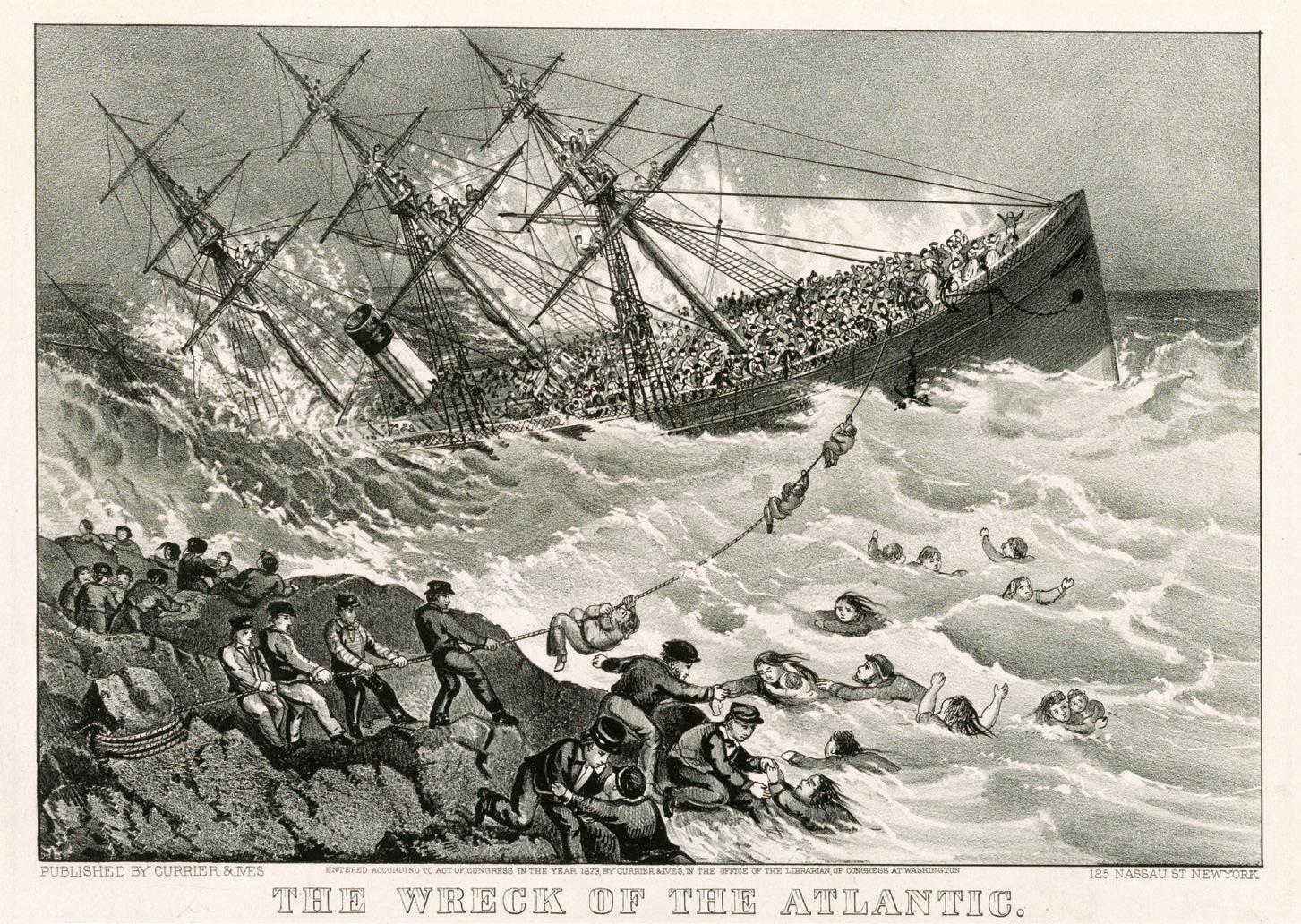
It was tough going because I do not read Spanish and not all newspaper issues were included. Perhaps I was spoiled by becoming accustomed to instant digital gratification.
The British Colonial Steamship Company (Temperley Line) was a challenge due to the difficulty of finding complete arrival/ departure dates at Quebec and Montreal.
From the introduction, I know Dick had many of the covers in his own collection. What was the process like for tracking
down and choosing other covers to illustrate the chapters? There are some chapters without covers – was there significant time spent searching for these?
Dick kept information on covers he had owned, including scans of some, but not all, as well as scans of covers sent to him for advice or analysis. He retained all the illustrated write-ups as an important resource for maritime postal historians. This allowed him to later contact specific collectors for scans of additional items in their
British & American Great Western City of Dublin Transatlantic Steam British Queen (Belgium) S.S. Massachusetts Sarah Sands Guadalquiver S.S. United States Sloman Line City of Glasgow Viceroy Liverpool & Phil. S. S. Co. Glasgow & New York S.S. Lafayette Ocean S.S. Co. S.S. Pioneer Pennsylvania S.S. Co. Atlantic Steam Nav. Co. Cunard Extra Sailings Clyde Screw Steam Co. General Screw London & Limerick Ericsson Tennessee Société Belge Franco Américaine
collections, or replacement images of those that had been sent to him as black and white photocopies many years earlier. It seemed less challenging to find images of important covers than it was to find images of key ships without having to pay exorbitant rights fees to use an image in print.
We wound up only paying for the rights to republish a few images as most were available from online sources without such requirements. The main problem with online sources was the poor resolution of many available images. We chose not to use any images that would not publish clearly. This turned out to be a good decision as we were quite pleased with the finished product.
With regard to covers missing from a couple of chapters – we simply could not find suitable examples!
Inevitably you have to decide when to stop – whether that’s researching, writing, or editing. Did this happen naturally or was it a difficult choice and why?
The logical stopping point – if one must stop – is at the inception of the General Postal Union on July 1, 1875 (having been negotiated and agreed in October 1874). After that, most but not all international postal rates became standardized for letters, postal cards and printed matter. Further changes were made at subsequent meetings. Those interested should read the wonderful book by Tony Wawrukiewicz and Henry Beecher, U.S. International Postal Rates, 1872-1996
In the Hubbard and Winter book of 1988, sailings of the North German Lloyd [Norddeutscher Lloyd] line to Baltimore and to Havana and New Orleans had been inadvertently omitted. That data was included in this volume as chapters 51 and 52 simply to close the loop as both contract and non-contract mails were carried. We decided to extend the sailing coverage on the latter route a few years beyond 1875 simply because we already had the data.
North Atlantic Non-Contract Steamship Sailings 1838-1875 by
Richard F.Winter and John H. Barwis. Published by the American Philatelic Society, Bellefonte, Pennsylvania, 2022. 8 by 10.75 inches, 318 pages. ISBN: 978-0-93358086-2. Available from the APS bookstore, https://classic.stamps.org/Publications. $60.
The book includes many details about the fates/journeys of various ships. Why did you and Dick consider this an important inclusion?
While the book is primarily about the mail rather than the ships themselves, postal historians can use not only the sailing data, but any other information that will help them understand or enhance the history of a cover. Letters given special postal treatment or were delayed by ice, fog, or mechanical problems are part of the “spice” and intrigue of maritime mails.
We take for granted that when we post a letter it will almost certainly arrive at its destination in a reasonable amount of time and in good condition. That was far less likely in the 19th century. Shipping in the North Atlantic held great danger – arguably among the most risky oceans to navigate (Figure 4). The economics of those routes were poor for all but a few companies, yet new entries kept trying. Presenting the difficulties and tragedies along with the successes makes it “real.”
It seems like there was significant effort made to make this book accessible to a wide variety of readers, skill level aside. And obviously the point of a book like this is that it should be usable and easy to reference. Can you share your philosophy about reaching your audience and how the book should be laid out?
The final format of the North Atlantic Mail Sailings 1840-1875 had a layout that was simple, consistent and easy to use, which we learned was quite popular. From the start of our work, Dick and I agreed that we would follow the format of the earlier book as closely as possible. The expectation
was that as a companion book any user familiar with the format of the first book would immediately feel comfortable using the companion book.
We wanted the book to be straightforward and easy to use for postal history students of any level of experience. At a colloquium many years ago, Peter McCann took questions after a presentation that had involved some research. In the Q&A period, a young collector asked Peter “Why do you do research?” Peter replied: “Because I like to find things out.” Dead silence in the room.
Dick and I hope that collectors will use our handbook to better understand their own covers and also appreciate those they see in exhibits or auction catalogs. The best place to start is on pages 310 and 311 (Figure 5). In less than a minute the chart will quickly identify the lines that may have carried the letter. Then it’s simply a process of elimination by comparing the origin, destination and date of a cover with the sailing tables in the appropriate chapters.
What’s changed, over the decades since North Atlantic Mail Sailings 1840-1875 was published, in the process of putting together a book like this?
The answer can be as short as two words: digital publishing. No more having
to retype an entire page or strip in a new line or paragraph. No more having to rephotograph and paste in images. Editing can be done and transmitted to the writer for correction in only a few hours. No more need to have a large inventory of unsold books – simply print batches to order.
What was the biggest challenge you and Dick faced? Or, were there any really positive experiences you want to share?
The work was not difficult, just timeconsuming. But it was also gratifying, and a pleasure to work with Dick.
What are you working on next?
I’m still working on early Australian colonial mail.
British Newspaper Archive, https://www. britishnewspaperarchive.co.uk/.
Genealogy Bank, https://www.genealogybank.com/ static/ppc/genealogy.php?intver=7D_6M&utm_ keyword=genealogybank&gad=1.
Lloyd’s Register of Shipping, https://hec.lrfoundation. org.uk/archive-library/lloyds-register-of-shipsonline.
Hubbard, Walter and Richard F. Winter. North Atlantic Mail Sailings 1840-1875 (U.S. Philatelic Classics Society, 1988).
Wawrukiewicz, Tony and Henry Beecher. U.S. International Postal Rates, 1872-1996 (Cama Publishing Company, 1996).
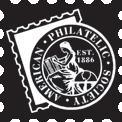


Most of us can relate to the joy of uncovering a special stamp or cover, especially if it is an item we have been hoping to find for a while. Eleven years ago, I learned that locating material in old stamp journals could provide the very same thrill for me. It was a glorious, unexpected surprise which affirmed that whether it is a product or information, ultimately the fun is in the hunt! And it all was even more thrilling when the hunt resulted in my book, Buffalo Cinderellas (Figure 1).
Avidly collecting stamps has been an interest of mine since I was 10 when my dad bought me an H.E. Harris Liberty album at Saturn Stamps in Buffalo, New York. I later worked in a stamp store for three years as a teenager, and joined the American Philatelic Society as an adult in 1982. For several decades my collecting world consisted of attending a stamp show every few years, subscribing to a weekly collector’s paper, and making philatelic purchases by mail in spurts. Yet my enjoyment of our remarkable hobby took off in an unanticipated way in 2012.

One of my ongoing pursuits has been locating items pertaining to the Pan American Exposition, which was a huge world’s fair held in Buffalo over six months in 1901. I somehow got the idea to put together what I envisioned would be a 16-page pamphlet detailing the souvenir stamps, now called cinderella stamps, pertaining to the Expo. Assigning numbers to each of these stamps was one of the project’s priorities, so I first needed to figure out exactly how many different were produced to promote the amazing event.
When I began investigating, it became clear to me that all of the stamps were mostly associated with two men. I learned their names and a preliminary search revealed that one was a good guy and the other was a vibrant, though very dishonest, character. I decided to expand my focus to search out as much information as I could about each of them, and hopefully write their biographies. I had no idea the challenge involved. Looking back, had I known what that ambitious task would require, I might have concluded the objective was too
big a pursuit. I’m very grateful for my naiveite, as the entire experience wound up being incredibly enjoyable, enriching, and satisfying.
Writing product descriptions has been a part of my professional work since I began mail order sales in 1979. After more than 30 years of preparing ads and designing collectors’ catalogs, I had a pull to express myself in a different way. I wanted to try my hand at writing narratives rather than just describing merchandise. So, I honored an inner voice to try to tell stories that were interesting and fun.
I took a leap and declared to family and several folks close to me that I was going to write a book. They were supportive, yet I also felt I’d have to let my efforts speak for themselves over time rather than just talk about my project.
So how does one begin to tell the life stories of two men who were not famous, who were both born in the 1870s, and who happened to be stamp dealers? I concluded the best thing to do was to contact the American Philatelic Research Library and schedule an in-

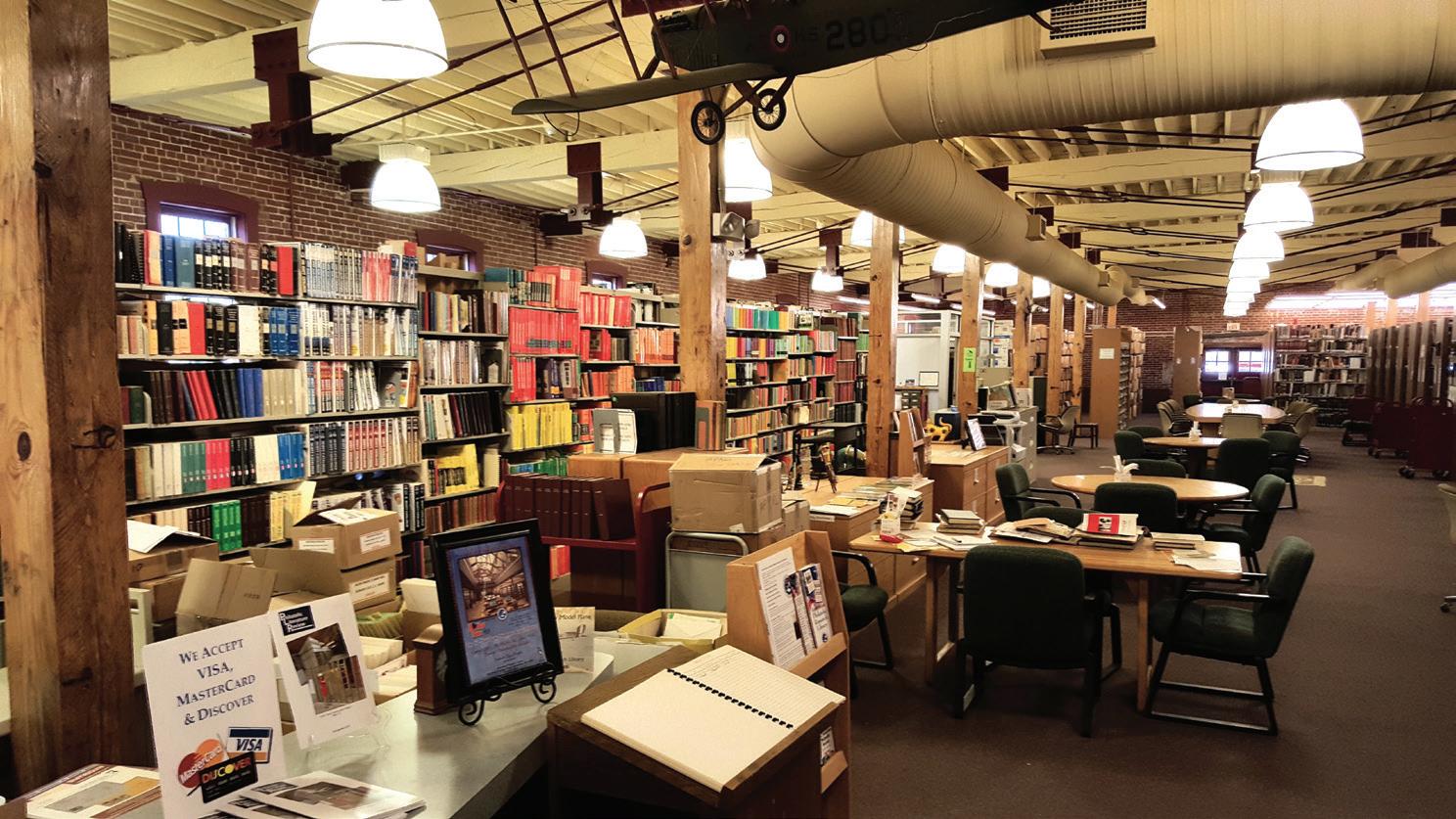
person visit. I provided the names of my subjects and an overview of my project, and in October 2012, packed my bags.
My mom, my wife, and I soon enjoyed a four-hour drive from Buffalo to Bellefonte on a Sunday afternoon, followed by a nice dinner. Then what a treat it was to arrive at the American Philatelic Center campus at 8 a.m. on Monday; I was completely blown away (Figure 2)!
After meeting head librarian Tara Murray and then reference assistant Scott Tiffney (now head librarian and director of Information Services), I was steered toward a table to set up my work station.
Two other distinct memories have stuck with me from that morning. First, there were a number of books, magazines, and old stamp journals that had been specifically set aside, 54 items in all, with a note on top that said “For Mr. Barrett” (Figure 3). It really showed me the helpfulness of the library staff, which is always eager to assist with locating pertinent materials.
And then, after a brief tour to learn where various items are shelved, I recall saying to myself “Wow! I’d like to live
here!” To me, the philatelic library was heaven. Little did I know that would be the first of many visits back the APRL; I try to go once or twice a year to immerse myself in the stacks. Again … the fun is in the hunt.
At that time, I had been an APS member for 30 years, yet that first inperson experience completely opened my eyes to what our amazing organization has to offer. I learned firsthand about the incredible resources available to me and all members. Even though I had thoroughly enjoyed supporting the non-profit, I feel that I moved from a passive APS member to a much more active and informed one. I began to enjoy more than just reading The American Philatelist each month, and my philatelic world grew tremendously.
I knew when I left the APRL that I was hooked! Before saying goodbye, I took pictures, made copies, and scanned various materials. And I learned that I could check out by mail up to five books or stamp journals at a time for up to a month. I was like a kid in a candy store and chose what bound items I wanted to immerse myself in at home, and ar-
ranged to have five items sent to me. That proved to be the first of around 80 batches of books I’ve gone through since that time. That’s close to 400 total publications that I have enjoyed reading in my own easy chair. The initial visit rocked my world and really turned out to be the first step of a six-year research and writing journey which was a wonderful labor of love.
While in Bellefonte, I learned tips to navigate the David Straight Memorial Philatelic Union Catalog, the tremendous online tool that allows one to search the holdings of multiple philatelic libraries. This easy-to-use digital resource has proved instrumental to explore and unearth various incredible assets.
After an APRL box was delivered to my home, I went through each publication, literally page by page, looking for any mention, feature, column, letter to the editor, or advertisement associated with Raynor Hubbell (the “gentleman” in my book) and William B. Hale (the “huckster”). When considering accessing hundreds of very old books or bound stamp journals, I had to simply guess which ones might have material inside that I was looking for.
I had some luck when reading periodicals from the 1880s, as Hale began selling coins and stamps by mail when he was in his teens. I accessed materials from a few years later too, as Hubbell’s philatelic activities began in the 1890s. His first of several retail outlets opened in Buffalo in late 1895. I learned that toward the end of that century, there were literally hundreds of stamp magazines being published, mostly monthly, yet a few had an even more ambitious publishing schedule. That meant there was a huge number of journals to consider and choose from when checking out materials for review.
I also guessed that certain East Coast journals were more likely to provide what I was looking for, as Hubbell was
from Western New York and Hale was from Central Massachusetts. My quest would later broaden as Hale began his travels all over the U.S., which moved me to inspect stamp journals from practically everywhere in America. His later globetrotting caused me to view numerous stamp journals from England and France, too. Overall, I was very lucky to continuously find material on each of these interesting men for many years, as they were quite active in various philatelic circles.
I became so immersed in locating any data I could on either man that I pursued widening my reach. I contacted the Rocky Mountain Philatelic Research Library and the Western Philatelic Library. Both entities were very helpful and allowed me to check out more materials, some of which were unique to their inventory. Their generous assistance actually sped up my process, as for an extended period over several years I had batches of books checked out of three different libraries, all at the same time.
In time, my initial idea of assigning numbers to the Pan Am Expo cinderella stamps caused me to ask several experienced collectors and dealers how they might proceed. The responses I received, independently of each other, was to contact philatelists at The Collectors Club of New York (Figure 4).
So, in September 2015 I arranged a two-day visit to the Big Apple, taking the train each morning from my late brother’s home in Connecticut. The welcome I received from several people, along with my attraction to the marvelous selection of literature there (Figure 5), caused me to join the prestigious organization. I got the assistance I needed to create a numbering system I wanted, and established a couple fine friendships which endure to this day.
As the accumulation of facts uncovered from several sources grew, what unfolded was like watching a fantastic

mosaic begin to take shape. Frequently one lead would open up ideas to pursue several others; one new discovery always seemed to point in the direction of another. It was an incredibly exciting time, as I certainly was having fun with the hunt. When I found mentions of Hubbell or Hale in old journals, I made copies of them and chronologically added those materials to folders I’d created for each man. By the time after many years that I was ready to begin my writing, those folders were 4 inches thick. Yet there were several more actions that helped add to those pages.
Hubbell was the more well-known of the two men. After the Pan American Exposition, he had a few more years in philately before turning to the corporate world for 40 years. When he retired from there in 1948, he donned his stamp collecting hat again.
Hubbell spent the final 13 years of his life focusing on promoting the world of Confederate stamps, suggesting that when the 100th anniversary of the Civil
War arrived in 1961, the focus on them would skyrocket. He wrote a regular column in the Weekly Philatelic Gossip and was the largest dealer in Confederate material of his era with an absolutely incredible inventory. Hubbell became active in the Confederate Stamp Alliance (CSA), now the Civil War Philatelic Society, and was the organization’s president for several years.
While pondering ways to acquire more detailed information on my subjects, I paused and tried to think out of the box. What came to me was to join the CSA and put an ad in the Confederate Philatelist magazine sent to members, asking if anyone might have known Raynor Hubbell 55 or 60 years prior. That meant connecting with a person in their late 70s or older.
A few months later I heard from a kind fellow named Col. James Monroe, who knew Raynor Hubbell; we spoke for well over an hour! He shared his fascinating tale as a teenager, being with the renowned dealer at stamp shows.

He invited me to attend the 2017 APS summer show in Richmond, Virginia and said that I might be able to meet a few others who also knew Mr. Hubbell. I did, and he was right; the personal connections I made at that event provided terrific human-interest perspectives that were really gold, and added to the story I was writing.
The success of my advertisement moved me to put an advertisement in Linn’s Weekly Stamp News, seeking materials on the other fellow I was researching, William B. Hale. I knew that connecting with anyone alive who knew Hale was pretty much impossible, because he passed away more than three decades earlier than Hubbell. Yet I was fortunate enough to connect with a collector who had an original promotional stock book for stamps that Hale gave away to customers and dealers during the 1890s; it was a fantastic find.
As more information regarding Hale
came into view, it was apparent that though he was a nice guy to be around, his business practices were dishonest. So much so that a he was twice arrested toward the end of his life, which opened another avenue for me to investigate and search out background about his legal challenges.
I called the Worcester House of Corrections, where his first sentence was partially served, and was directed to the National Archives to obtain records. They had some fascinating prosecutorial minutes of Hale’s two arrests. And when I inquired about what occurred after he was found guilty the second time, I was directed to the Department of Justice. For an average guy, this was a riveting journey to find myself on, and I simply walked through each door which was suggested and opened for me.
In order to obtain Hale’s prison records, I needed to file a Freedom of Information Act request. One hears about



those things a lot on the TV news, so I assumed it was an involved process and a big deal. It was actually very easy! I simply filled out an online form of what I was looking for, paid a small fee, and eventually connected with a research assistant who could maneuver through archival materials.
I had to characterize whether I had a simple request or an involved request, and mine definitely required some indepth searching. I wanted to know where Hale served his time, whether he was eligible for parole, when that might have been granted, and when he was released. Since I had a self-imposed deadline approaching for me to begin writing my book, I asked if my request could be expedited, and it was. I was floored when I soon received by email the exact information I was hoping to find, which I was told was all on a deteriorating piece of microfilm. Thank goodness the data was still readable; it was absolutely magnificent to obtain.
Another lead that I followed was to contact the Masons organization in Massachusetts. A person well versed in locating files assisted me by finding a card with Hale’s induction data and
other info. It would later help in confirming the charlatan’s date of his death. I laughed when I saw that it listed his occupation as “musician!”
Since the exact date of Hale’s demise seemed to be a mystery (as my gut told me it had been mis-reported in the philatelic press), I again contemplated options to reveal the truth. I contacted the Massachusetts Department of Public Health’s Division of Vital Statistics and filled out a form to obtain William B. Hale’s Standard Certificate of Death. Six weeks later I literally got goose bumps when the official document came in the mail on a Saturday afternoon.
The whole process was like being on a literary scavenger hunt, and it was a very exciting ride. I reached a point where stamp journal pages and additional Google searches brought less and less of a return, so I knew I was about ready to begin my writing and let the stories come into view. Towards the end of my process, which I certainly could have done sooner, I purchased memberships at Ancestry.com and Newspapers.com; both provided some excellent data and visuals to add to my text (Figure 6).
When it was time to refer to the mas-

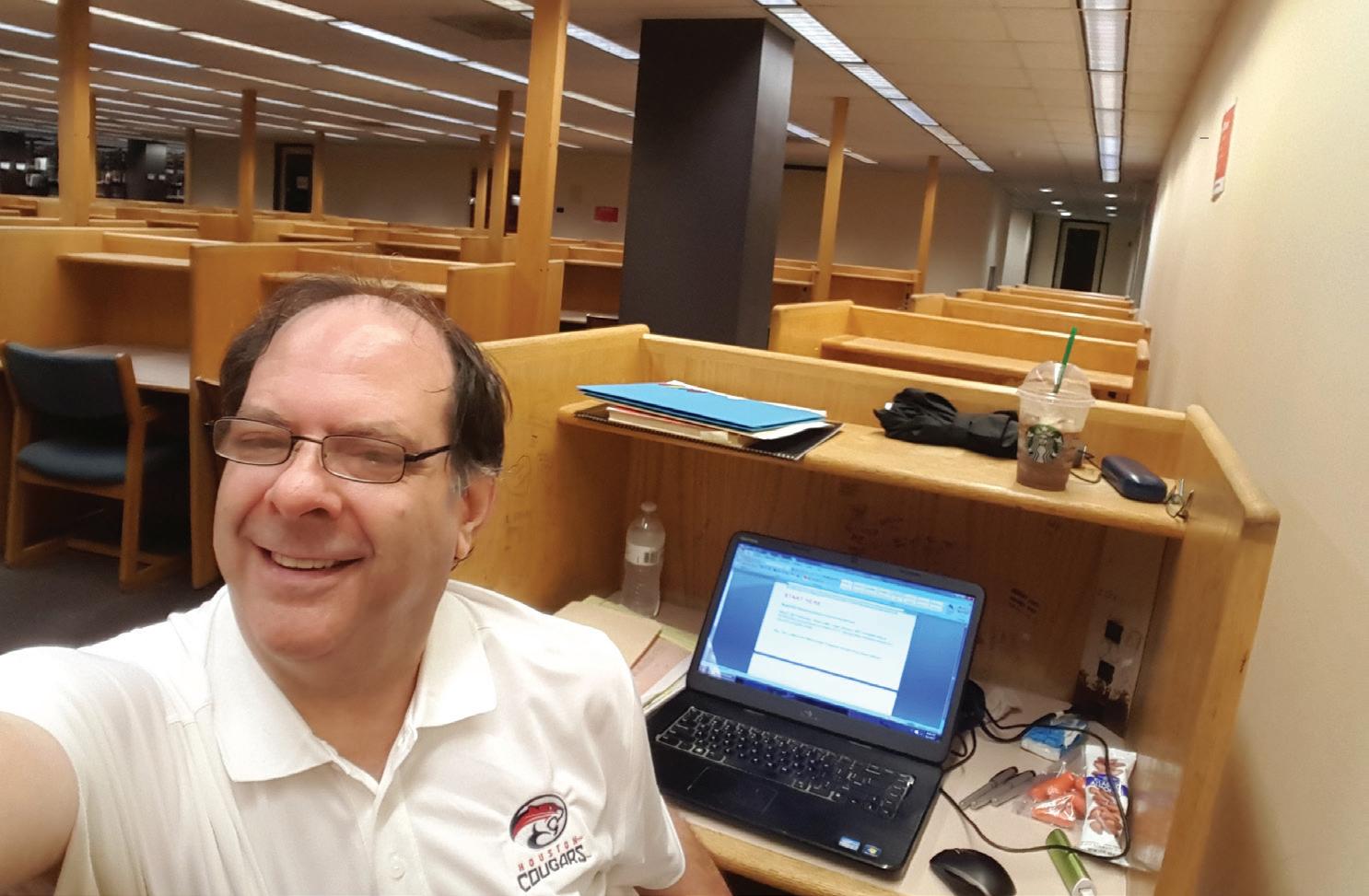
sive amount of material that had come my way over five and a half years, I chose to completely throw myself into the writing process. I felt that if I began typing at home that I was opening myself to interruptions and distractions. So, I made a schedule for the next 11 weeks to spend two days a week at the library on the central campus at my alma matter, the University of Houston (Figure 7).
It was exhilarating to make time in my life to do nothing but write on those days; I began each one with a 6 a.m. trip through the drive-through at Starbucks. A half an hour later, the pleasure of strolling across campus to my selfdesignated writing cubicle was wonderful (Figure 8). I worked from an outline I’d made that included titles of chapters in my book and most of the time wrote chronologically from the huge number of photocopies and notes in my files.
Lunchtime took me to the student union where I ate with youngsters four decades my junior; they provided an awesome energetic feeling which kept me amped up to continue my work. At
5 or 6 p.m. I would find a smart place to pause things and headed to the parking garage. While heading home at first, I thought that writing just three to five pages was a failure, even though I felt confident in the essence of my work. I soon made peace with things, and became very comfortable with “quality over quantity.” As my 22nd and final day of writing approached, an inner voice told me something of substance had come from my process.
I then worked with several editors, one for flow, one for grammar, and one for philatelic content. I also was extremely fortunate to have connected with a retired University of Buffalo professor who was an expert on the Pan American Exposition. He graciously read my chapter on the memorable world’s fair. All of the editors’ input was impactful and most welcome; they certainly helped improve the publication dramatically.
Next, I worked meticulously on the content of the 24-page Stamp Appendix (with a numbering system), which was extensively illustrated. I wanted to hon-
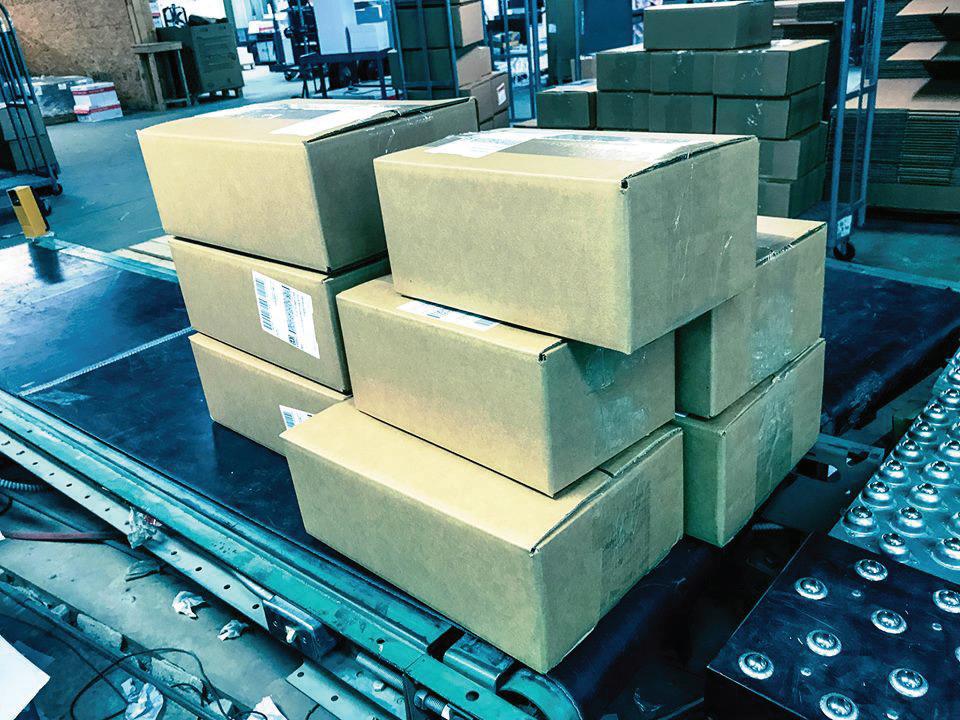
or my initial intent and provide a quality roadmap for philatelists to learn about and build collections of Expo souvenir stamps.
I had chosen my cover image years before from five different that were created, yet as I neared my finish line, I enlisted the help of a local graphic artist. Having designed well more than 100 memorabilia catalogs for my business in the 1990s, I was still somewhat adept at image work. Yet there were certain tasks I still needed assistance with, and she was a marvelous asset and consultant.
Her advice and suggestions made the quality and appearance of my book even better, for which I am very grateful. Her premier knowledge of the software I’d chosen to layout my book myself was impressive. I’ve always enjoyed reading material with the text attractively wrapped around a lot of images, rather than simply stuffing all the pictures onto
a number of pages in the middle of a publication. With her guidance I feel I was able to create an eye-catching composition, that flowed beautifully and would keep readers engaged.
Though I’ve lived in Houston since 1975, it just felt right to consider unveiling my project in my hometown of Buffalo. So, I contacted members of the Buffalo Stamp Club, which I then joined, to inquire about doing an inaugural presentation at the annual BUFPEX show. They were happy to oblige, as was the Buffalo History Museum, which also was interested in a talk. Those dates were put on my calendar, which then specifically put me on the clock. I worked for 29 of 31 days in a row to finish my amazing undertaking, and finally completed my six-year odyssey!
Probably the best thing my graphic artist did for me was to recommend that I receive samples from the company that

I’d chosen to print my self-published book. When those were received, I knew that I had to look elsewhere, as the paper thickness and colors were just not to our liking. Calls to several philatelic authors brought me a highly regarded referral to a threegeneration printing company that was experienced in producing serious stamp collecting reference guides (Figure 9).
The company understood our required detail to accuracy with regard to color hues, and were well versed in our specific hobby needs. The company was even kind enough to provide me with pictures of producing my project along the way, as well as an intriguing video clip of various color pages being printed that I used on social media to create excitement for my project.
Soon thereafter, three of the 18 boxes of high-quality hardcovers were delivered directly to me at BUFPEX 2018 while the rest arrived in Houston a week later (Figure 10).
I was proud and elated to see the
finished product, which was a far cry from my initial dream of a 16-page pamphlet (Figure 11). While waiting for the printer to work its magic, I worked on creating materials for a signed Limited Edition and had a handful of sheets of cinderella stamps made up, picturing the stamp on the book’s front cover.
My next task was to mail out some review copies to various publications, most of them philatelic related. It wasn’t long before numerous positive features appeared in print and sales of the book took off.
A few months later, Buffalo Cinderellas won an American Philatelic Society gold medal at the 2018 APS summer StampShow (Figure 12), which was followed up by a large vermeil medal issued by the Chicago Philatelic Society’s Literature Exhibition.
I never expected to receive such positive feedback, some from long-time, experienced book reviewers. One veteran wrote “This is one of the most interest-

ing and enjoyable books that I have had the privilege of reviewing over the past 20 years as Book Review Editor.” (The Cinderella Philatelist, July 2018, Volume 58, No. 3 page 98.) It was a rush to do several book signings and stamp club presentations around the country.
I was later able to contribute to our hobby by doing Zoom presentations during the pandemic when many clubs and collectors were anxious for interesting and highly visual, captivating content.
I must say that when I started on this enticing path in 2012, I NEVER expect-
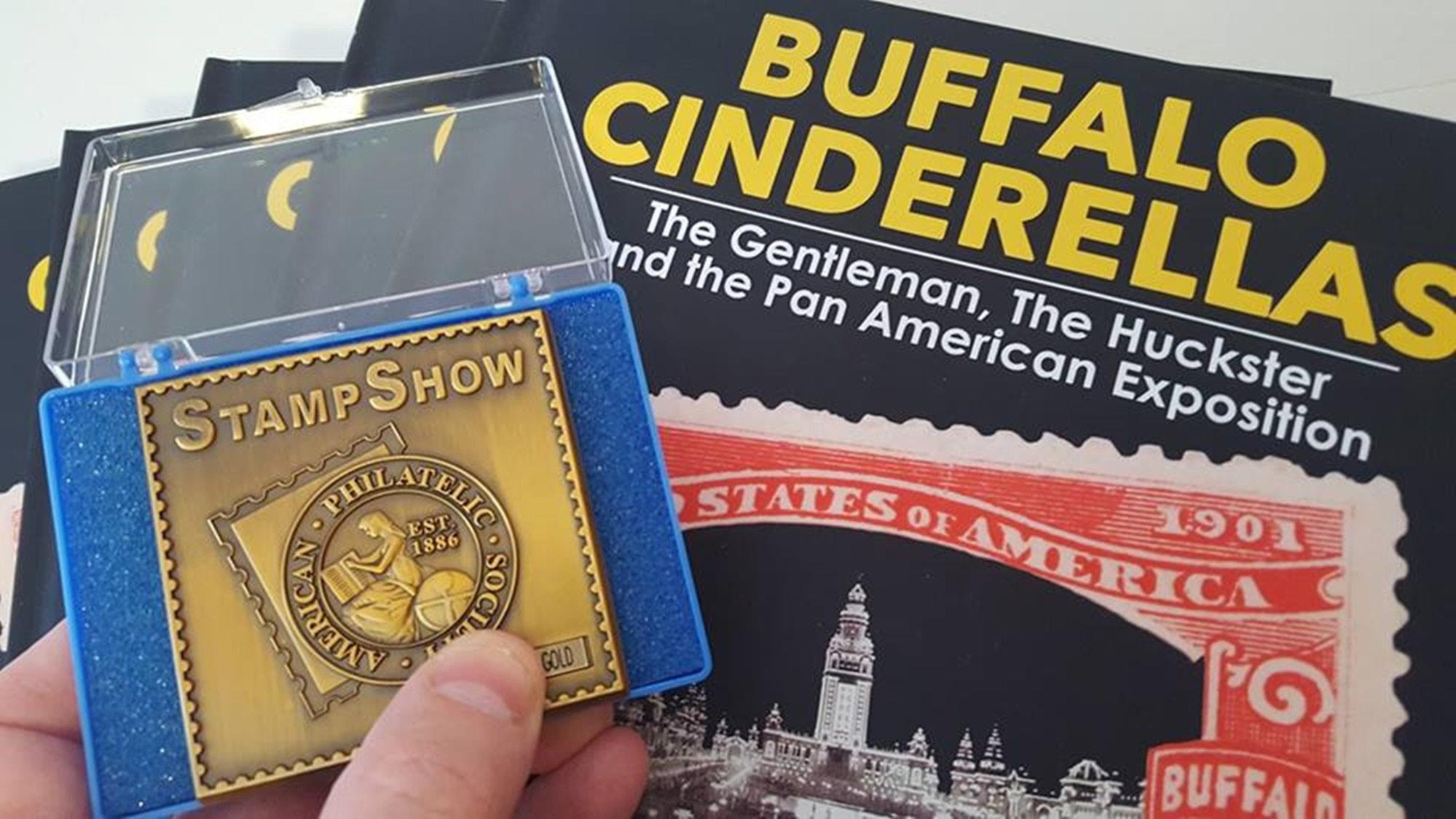
ed this amazing outcome. It was an incredible six-year ride followed by several years of exposure and marketing.
This book started with a simple idea to produce a few pages to help other collectors interested in putting together sets of Pan American Exposition cinderella stamps. Instead, what unfolded was an unfathomable adventure which allowed me to expand my enjoyment of philately to unexpected new heights, meet dozens of really good people while on my publishing journey, market my book with additional feature writing, and meet numerous collectors everywhere through presentations about misters Hubbell and Hale.
Many times, when I wind up a talk, I like to provide encouragement to follow
any kind of whim that you may have about an area that you collect. I say “If you have any interest in a certain area of philately, why not consider writing about it?”
Whether a finished product is a contribution to a stamp club’s newsletter or other publication, or is a pamphlet or a book of any size, the adventure can be wildly enjoyable. Don’t forget that the American Philatelic Research Library is a welcome and willing friend that will assist however it can.
And remember, fellow collectors are frequently able and willing to connect with the interests of others. Simply following one’s passions will not only provide a gift to our magnificent hobby, but what one receives in return may be incredibly startling, too. Good luck!
Rick Barrett has collected stamps for the past 55 years thanks to his late Uncle Clark. Barrett worked in a stamp store for three years as a youngster and has always enjoyed expanding his philatelic awareness. He joined the American Philatelic Society in 1982, and is a member of several other collecting organizations. Barrett loves sharing interesting philatelic stories, many of them uncovered at the American Philatelic Research Library. His first book, Buffalo Cinderellas, was wonderfully received and has won two awards, including an APS gold medal literature award. Buffalo Cinderellas is available at the APS gift shop or at the APS website. Barrett’s APS Chatty Award-winning Stamp Chat presentation about William B. Hale, “The Wild Life of a Philatelic Swindler,” can be viewed on the APS YouTube channel.
18th New Zealand Philatelic Literature Exhibition

Christchurch, New Zealand
25 -26 November 2023
Entries are called for from Authors, Publishers, Societies, Webmaster etc For Prospectus visit; www.cps.gen.nz
Competitive entries to be received by 1 October, 2023
The first philatelic journal, The Monthly Advertiser, was published on December 15, 1862. Over the next few decades, until the new century, hundreds of them took birth; most died after a few issues and well within their first year.
These 19th century periodicals were usually not worth the paper they were printed on and perhaps deserved their inglorious end. Almost all of them were amateurish and contained very little original material. Their format was standard: a column or two on stamp collecting, a bit of gossip, some news especially new stamp issues, a few offers of rare (!) material, advertisements (not all of which were philatelic such as on cycles, umbrellas, shoes, jackets, and so on), and the invariable call for sending in the yearly subscription. I wonder whether readers were refunded any amount once the paper shut!
An analysis (Figure 1) shows that the United States led the way in producing philatelic trash with just a bit more than 3 percent of journals published up to 1900 existing at the end of 1900. In India, of the eight journals (all published in the 1890s), only two lived to see the 20th century.
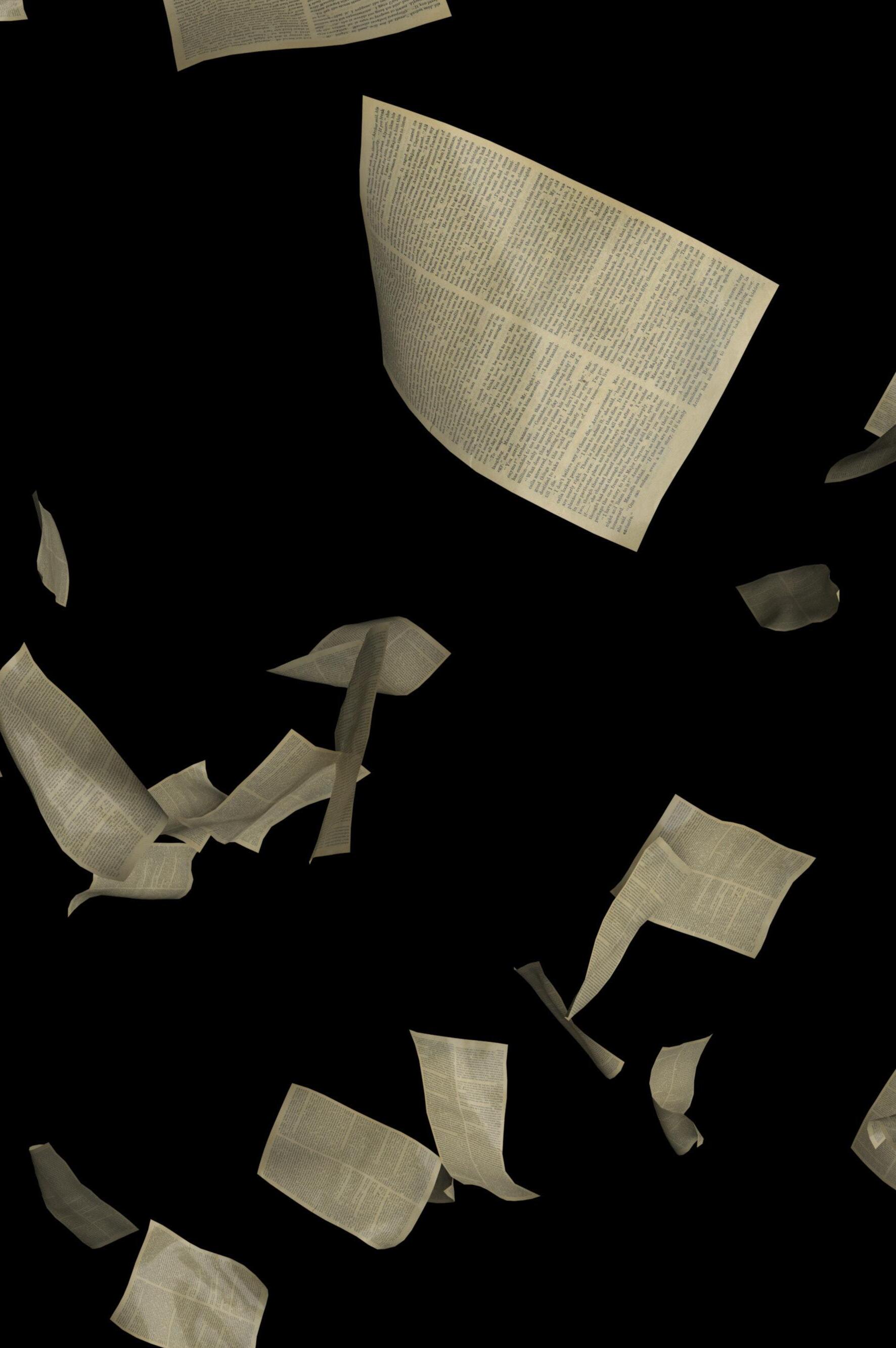 Abhishek Bhuwalka
Abhishek Bhuwalka

Years back, when I was browsing the Catalogue of the Crawford Library of Philatelic Literature for Indian journals, I came upon an entry (Figure 2) on The Young Postage Stamp Collector.
The description was intriguing – a print run of just “about ten” and issued as a skit by E.W. Wetherell, a renowned philatelist, someone who would edit two of the best journals of their time, The Philatelic Journal of India and The Philatelic Journal of Great Britain. I just had to
see what was in it!
Unfortunately, this journal hadn’t been digitized by the British Library (BL); or if it had been, it wasn’t available for download (still isn’t) when I searched the Crawford library using the then recently launched website of the Global Philatelic Library. Shortly thereafter, when on a trip to London, I visited the library and took a scan of this journal. I present its three pages; the fourth is a blank (Figures 3 and 4).
A quick glance brings about deja vu;

any stamp collector of those times would have seen plenty of similar looking periodicals. The Young Postage Stamp Collector mimics and ridicules their layout and contents. It imitates not to flatter but as a parody. Note the deliberately bad English and spelling errors sprinkled throughout. Excerpts are reproduced below:
Send for our price list of ladies, and gent’s and shoes fit and Workmanship gnaranteed (sic)
PEARSONS! PEARSONS!! PEARSONS!!! The original house in Bangalore for oils, varnish, pants, cement, bricks, tiles and kanker
Sir Rowland Hill was the first discoverer of stamps he will be remembered always for that reason
Many native states in India use their own stamps, some are very rough designs and show sometimes portraits of rulers which are often ugly and struck by hand
Never stick stamps down too tight or they may get spoilt when you soak them off such as Russians which come off when whetted (sic); as they are water colours
Deal of a reliable dealer, Messrs Stanley and Gibbons are very reliable, they are the Publishers of the album I use
I have seen a very good paper called Gibbons Stamp weekly edited by Mr. Nankivell who is a very littery (sic) gentleman, there is a good story in it called the stamp king.
The collection in the Museum here is very poo (sic). There are only 60 or 70 and most damaged.
A search of the Global Philatelic Library shows that only one copy exists, which is in the British Library. However, we know that the library of Thomas William Hall (Figure 5), past president of The Royal Philatelic Society London (RPSL) and editor of The London Philatelist, contained a copy and that his library was donated to the RPSL by Mrs. Hall in October 1937.
Ernest William Wetherell (Figure 6) was born October 12, 1869 in London. After school, he studied at the Royal College of Science, South Kensington. In 1894, he was awarded an Associateship of the Royal College of Science (ARCS), an honorary degree-equivalent award. He became a fellow of the Geological Society in 1891.
Wetherell began his philatelic career at the age of 5 starting with the English 1d reds, which he threaded on cotton, instead of using an album! He advanced in his collecting and by the time he finished school he had 1,700 to 2,000 varieties in his album. And in some years, his collection grew to about 9,000 and by 1902 to as many as 40,000 items! (This was one of the ways a collector was judged or talked about in those days: how many specimens / varieties he or she had in his or her collection.)
Wetherell collected principally Great Britain and European countries and also fiscals, forgeries, and reprints. He later became a specialist in the stamps of Holland.
Wetherell went to India to take the post of second state geologist and assistant secretary to the government of Mysore, Geological Department and professor of geology at Central College, Bangalore. He started the Bangalore
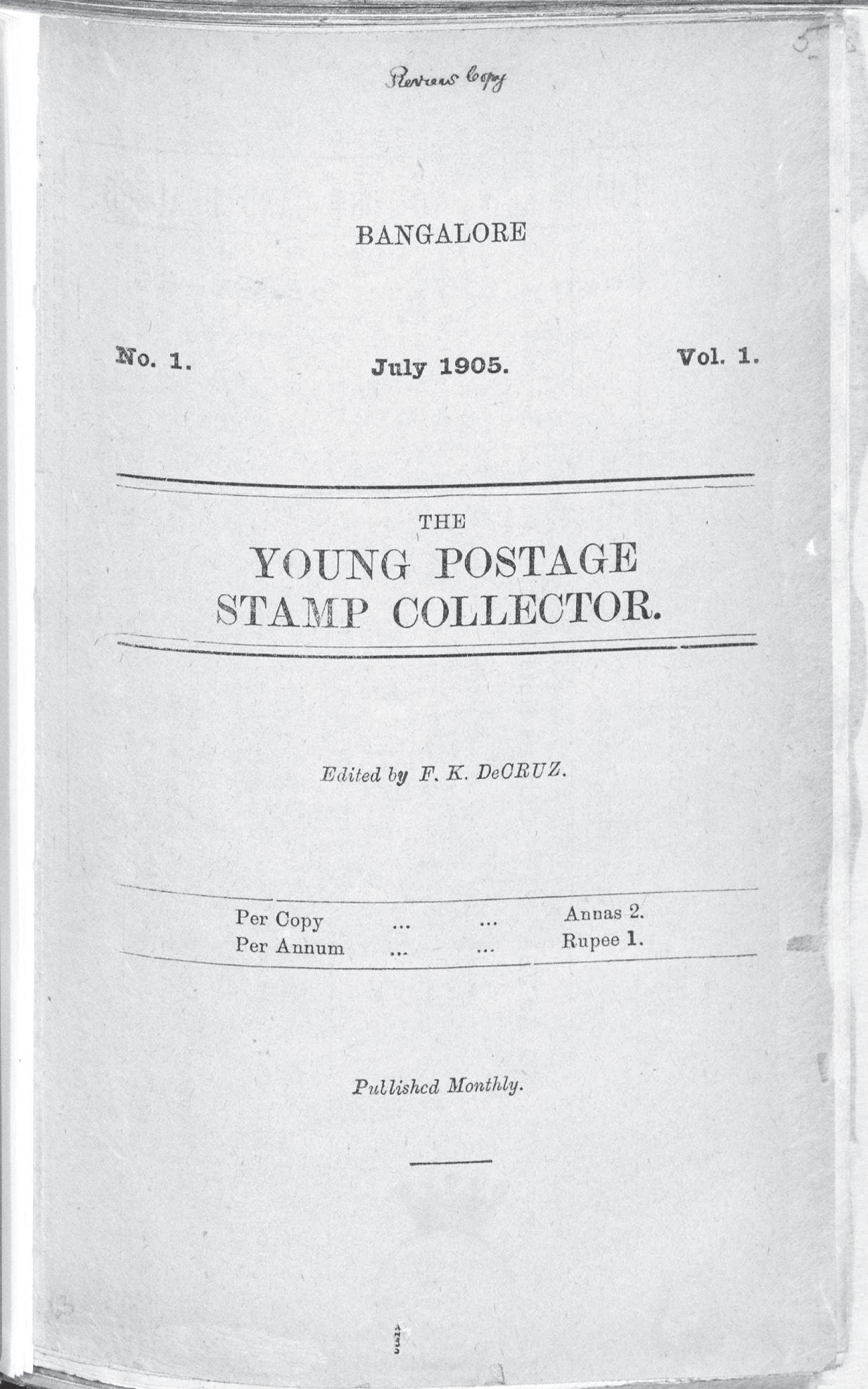
Stamp Club and was its secretary. He later became one of the council members of The Philatelic Society of India. He was a prolific contributor to and later edited its world-class journal – The Philatelic Journal of India – in 1902, 1905, 10 months in 1906, eight months in 1909, 1910, and the first six months in 1911. However, he fell seriously ill
which meant that six numbers of JulyDecember 1911 were never published.
Back in England, he was a regular feature at the meetings of the RPSL; he had been elected a Fellow in 1907. In 1915, the Indian government decided to present the RPSL with nine lithographic stones and four engraved copper plates that had been used in the production of the

1854-55 first issues of India. Wetherell is recorded as being among the 18 members and four visitors present on March 13, 1916 when the handover took place.
A photograph showing 21 of the 22 members was taken on the occasion (Figure 7) but wasn’t annotated to identify the faces. Seen are President M.P. Castle (seated second from right); the Hon. Librarian L.W. Fulcher (seated
second from left); L.L.R. Hausburg who wrote the definitive book on the stamps of British India published 1907 and to whom the offer of the stones and plates were originally made (standing third from left); T.W. Hall (standing fourth from left); E.D. Bacon (standing eighth from left); Wilmot Corfield (standing second from right); and Percy de Worms (standing third from right). All great
philatelists. If I must guess, I think Wetherell would be the one seated first from left.
From 1917 to 1920, Wetherell edited The Philatelic Journal of Great Britain, the organ of the International Philatelic Union, an organization of which he was a member since 1887.
Wetherell died on July 21, 1933. He had been plagued by illhealth for a considerable period of time. Upon his death, his wife donated his “Study of the 5 ct. Holland of 1872-91” to the RPSL.
Note: A version of this article first appeared on my blog (thephilatelist.substack.com) and website (philaliterature.com) on November 29, 2022. It has been expanded for publication in this journal. Regulars will notice (I hope!) the different style in which it’s written compared to some of my other articles – informal, racy, and no footnotes! Curious readers are encouraged to go down the rabbit hole of philatelic history and literature by looking up the references, especially Birch’s works on the Global Philatelic Library website.
“The Hall Library.” The London Philatelist. XLVII no. 555 (March 1938): 57-58.
“Notable Philatelists. E. W. Wetherell.” The Philatelic Record. (July 1903): 128-130.
“Occasional Notes.” The London Philatelist XLII no. 499 (July 1933):166
“Well-known Philatelists. No. 27-Mr. E. W. Wetherell.” The Philatelic Journal of Great Britain. XII no. 135 (25 March 1902): 3334.
Birch, Brian J. 2018. Biographies of Philatelists and Dealers. Montignac Toupinerie, France: The Author http:// www.globalphilateliclibrary.org/birch/


Source: The Philatelic Record
BiographiesOfPhilatelistsDealers.pdf
Gilbert-Lodge, L. J. “The Royal Philatelic Society, London. Annual Report for the Season 1933-34.”
The London Philatelist. XLIII no. 510 (June 1934):
122:137
Maassen, Wolfgang, and Vincent Schouberechts. Milestones of the Philatelic Literature of the 19th Century / Les Jalons De La Littérature Philatélique
Philatelic Society
London.
Source: The London Philatelist (June 2011).
Au XIXe Siécle. Monaco: le Musée des Timbres et des Monnaies de Monaco (=Club de MonteCarlo), 2013.
Mann, Eric W. “The Society’s Collections.” The London Philatelist. XLVIII no. 568 (April 1839): 108-112.
Negus, Ron. “The Gift from India.” The London Philatelist. 110 no. 1286 (June 2011): 143-144.
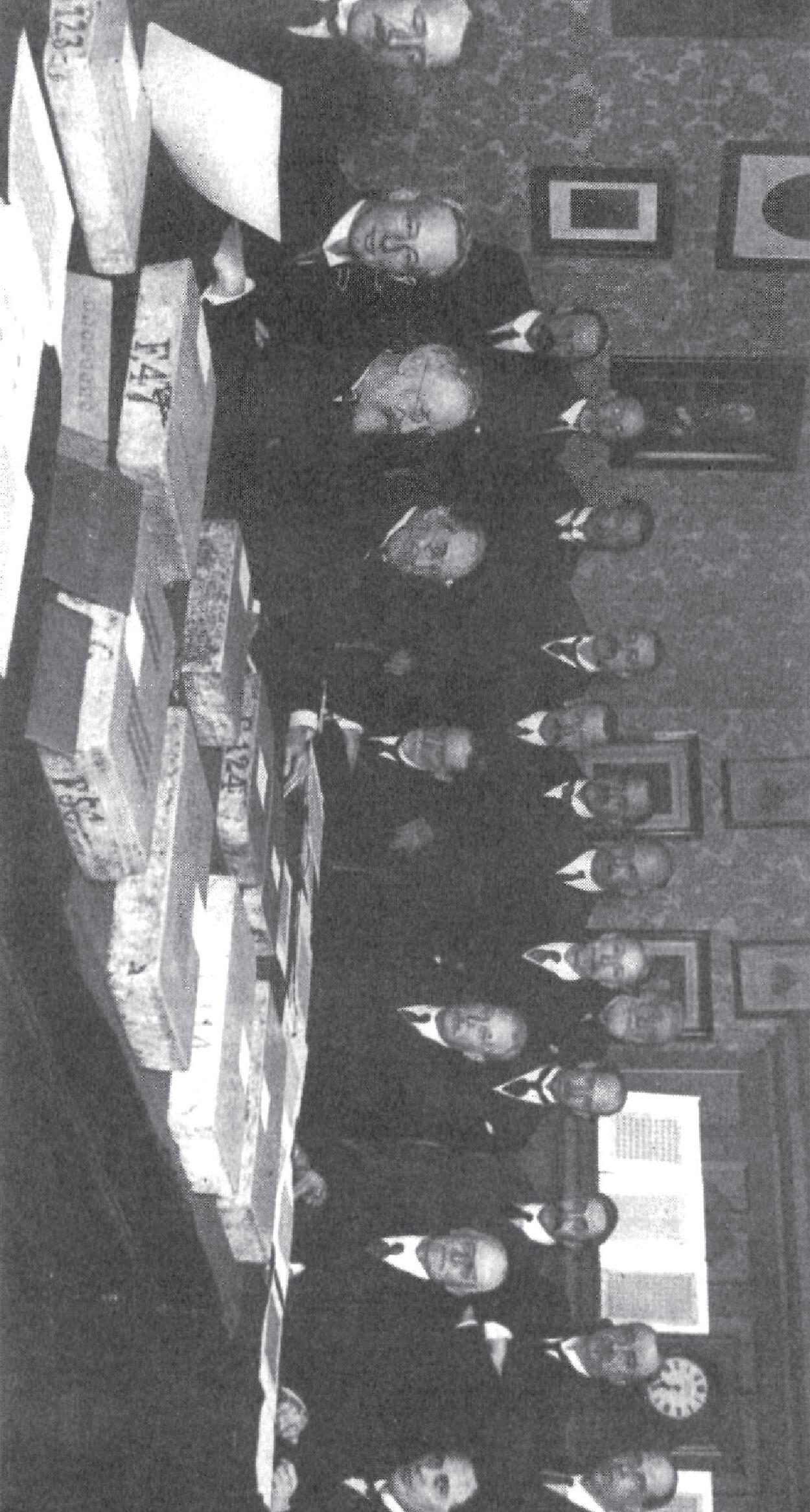

There’s an old philatelic adage: “Buy the book before the stamp.” Having even a rudimentary knowledge of the area one collects makes sense. It makes even more sense to gather that information in advance of a deep dive into, say, such areas as United States locals or Confederate States, each with their many forgeries, reprints, and similar pitfalls waiting to entrap the uneducated collector.
My particular collecting interest involves the U.S. private die proprietary revenues, the so-called match and medicines, or M&Ms for short. A firm grasp of this byway of philately is founded on five books which, to my mind, every M&M collector should access or possess. They are:
An Historical Reference List of the Revenue Stamps of the United States, including the Private Die Proprietary Stamps (original 1899), by Toppan, Deats, and Holland. It is popularly known as the “Boston Revenue Book.”
United States Match and Medicine Stamps (1980), by Christopher West.
Private Die Match Stamps (1980), also
by West.Patent Medicine Tax Stamps (1979), by Henry Holcombe. Griffenhagen’s Private Die Proprietary Medicine Stamps (1969) is an adequate substitute for the out-of-print and costly Holcombe treatise.
Scott Specialized Catalogue of United States Stamps and Covers (annual), from Amos Media, Inc.
Armed with these five texts, the M&M enthusiast will have more than a basic knowledge necessary to intelligently delve into this fascinating collecting specialty. One could well stop there, confident that one’s stamp library is sufficient to become a well-rounded student in this area.
However, one can (and, I say, should) venture beyond this point, which brings us to a sixth volume. Countless monographs, catalogs, and articles exist in this particular field, all readily available through the auspices of the American Philatelic Research Library. Here, revenue collectors have a huge leg up on their postage-collecting brothers and sisters.

Ron Lesher said it best when he noted that no other branch of philately can boast what revenuers possess, Riley’s Fiscal Philatelic Literature Handbook. Published in 1997 as the June issue of The American Revenuer, the journal of the American Revenue Association, this monumental compendium is a bibliography of catalogs, monographs, and pamphlets, as well as an
index to revenue articles that had appeared in serial publications.
This latter portion has more than 10,000 citations from some 750 publications, ranging from the obvious, such as The American Revenuer, The American Philatelist, Linn’s Stamp News and Mekeel’s Weekly to unbelievably arcane and often short-lived periodicals. That one man could possibly

peruse so many publications and derive there from this magnum opus is simply astounding, to whom every revenuer owes their eternal thanks. But Riley surely benefited from indexes previously published. I refer to a thorough index of revenue-related articles in Mekeel’s compiled by Clarence Chappell in 1957.
Also, long-running periodicals like The AP and the Revenuer print indexes to articles that have appeared in their respective volumes, typically covering the previous year or two years of issues. And let’s not forget the PLR’s own magnificent publication (more than 600 pages) of William Ricketts’ index to English language philatelic publications up to 1926.
I used to live in the Midwest, and I have relations residing in central Pennsylvania. I would arrange to spend a day at the APRL during my visits there. I felt a need to expand my philatelic library, and my knowledge base, by utilizing the library’s vast holdings. Armed with a long list of 158
M&M-related entries from both Ricketts and Riley, over the course of a dozen years I managed to photocopy every article I felt to be pertinent to my understanding and appreciation of this field. I recently donated a copy of my listing of M&M articles in the serials literature to the APRL.
I do not claim to have captured every single line ever published about M&Ms; indeed, that was never my intention.
Those articles with very basic information, chit-chat, and some of the chronicles of new issues were intentionally left out as either uninformative, unimportant, or redundant. This still resulted in some 1,180 separate entries, ranging from as early as 1871 to the present, and covering 88 different philatelic publications. Forty percent of this number came from the Revenuer, followed by Mekeel’s at 16 percent, AP and Linn’s at 5 percent each, Weekly Philatelic Era and Metropolitan Philatelist at 3 percent each. A number of publications are represented by single entries.
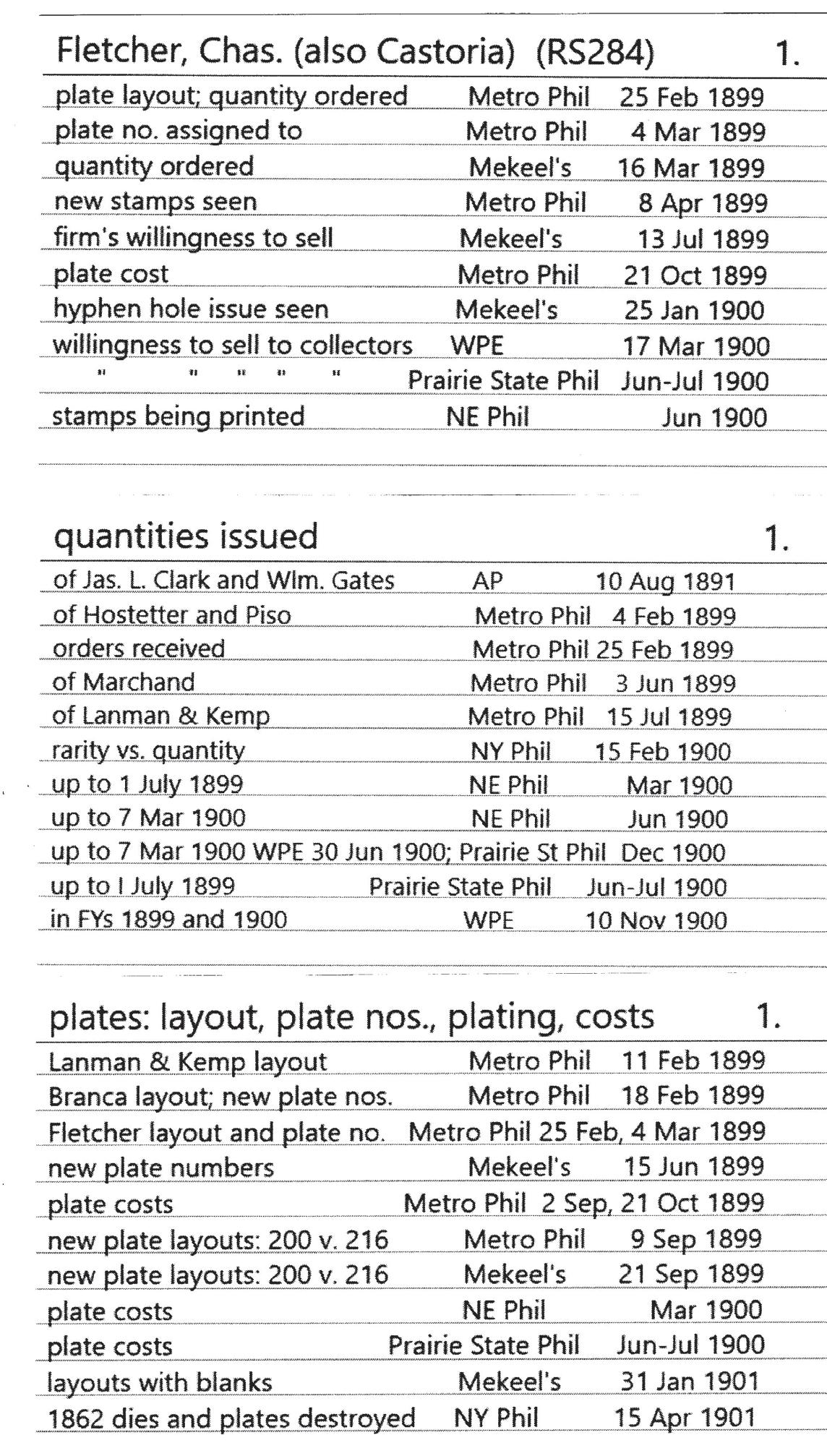
I happen to own a complete run of The American Revenuer, so I didn’t need to photocopy any of the nearly 500 M&M-related articles that have appeared therein over the last 75 years. But I found it useful to break these down into five main headings for ease of reference: cancellations, die and printing
varieties, facsimiles and collateral, histories of M&M firms/product information, and miscellaneous.
As I compiled my listings, I also found it helpful to expand on the bare-bones information used by Ricketts and Riley in theirs. For example, a Ricketts entry for “1898

Issue-Marchand, Charles” was expanded to “Marchand: quantities printed,” which is what the snippet referred to was about.
Now, having all of these photocopies cataloged and bound in six three-ring binders (Figure 2) provided me with the physical information I desired right at my fingertips, right? Well, yes and no.
I had the information, but it really wasn’t very accessible. For instance, if I wanted to review any articles published on double transfers known on, say, the 2-cent Jayne medicine stamp, my only way to locate it was to revert to the Ricketts and Riley indexes, hoping that they were detailed enough (and also remembering that they are 100 and 25 years out of date), or to thumb through all of my entries. It became apparent that I needed to make an index of my own.
Thus began the second stage of my research and reference work. Using 3-by-5 index cards, I would enter on a separate card anything related to M&Ms in all of its facets for ready retrieval.
As an example of my cross-referencing, in the February 25, 1899 issue of The Metropolitan Philatelist, an item notes that Charles H. Fletcher had placed an order
for 200,000 of his private die proprietary stamp, arranged 6-by-21, leaving one blank space at the bottom of the pane to facilitate counting. Thus, entries in my index cards (Figure 3) are found for “Fletcher,” “quantities issued,” and “plates: layout.”
In addition, if an article described, say, 20 double transfers the author had noted on various M&Ms, rather than simply adding an entry to the “double transfers” index card, I made it a point to add individual entries under each of the company names with the stamps with double transfers. Extra work, sure, but a truly useful cross reference needs to be just that.
This project kept me occupied for several years, and I spent most of one winter digitizing my handwritten entries so that I could deposit my M&M index to serial publications with the APRL, for all to use. An example is found at Figure 4.
Nearly all of these entries are available at our very own APRL. One can also sometimes find back issues of such periodicals as Mekeel’s in university and state libraries, perhaps on microfilm or fiche, as I did by happenstance. Conversely, a tiny fraction of the articles for which I was searching were missing at the APRL due to
incomplete runs. These numbered perhaps a dozen or so articles, almost all from obscure publications. At least one was later obtained through interlibrary loan, another option for researchers.
I do not restrict my index to purely philatelic publications. My searches have occasionally led me to pertinent articles in the popular press, magazines dealing with history, and druggists’ trade journals. Another 17 such publications made it to my list, including The South Atlantic Quarterly, Scientific American, and Pharmacy in History.
There are a number of entries, too, that come from sources other than journals and periodicals. The prime example is the correspondence file of Elliott Perry (pen name Christopher West) held in the APRL. Perry corresponded with such M&M luminaries as Sterling, Deats, Holcombe, Joyce, Riley, and Springer over a remarkable span of 50 years. Here is a trove of information found nowhere in print. I have copied 52 of these letters dealing with M&Ms, and they are all appropriately indexed in my files.
In short, I include any item that strikes me as worthy of being indexed, regardless of the source. And the good news is that
nearly all came from publications and files one may find on the shelves in Bellefonte.
Now, if your level of collecting requires only a Scott catalog, then more power to you. If you find, on the other hand, that you want to assume the role of the researcher in order to delve more deeply into your particular collecting interest, then you will do well to do as I did. Use your library! Very likely you will uncover tidbits of information published many years, decades, or a century ago, long forgotten until your diligence pays off.
As in the hunt for that elusive stamp, there is a certain thrill in the chase for the arcane article that finally answers that question you’ve had about that odd postal rate, obscure post office, special flight, or what have you. I have been at it for 20 years, and I still have new lists of articles to look up whenever I’m next in Bellefonte.
Lastly, when you feel that you have compiled enough articles, I encourage you to follow my lead. Please donate a copy of your list and/or index to the APRL. Rest assured, fellow and future philatelists will thank you for your foresight and kindness.
Paul Weidhaas became a life member of the APS in 1987. He has served as the manager of the U.S. sales circuit program for the American Revenue Association since 1994. Weidhaas formed an eight-frame exhibit of match and medicine multiples, which garnered a gold medal when it was first displayed at the 2004 St. Louis Stamp Expo. He has written numerous articles for the American Revenuer, including an update of Richard Riley’s checklist of M&M multiples. He has made several discoveries of M&Ms previously unknown to the hobby.
The backstory of my new book, First Class: America’s Marvelous Midcentury Stamps, (Figure 1) originates when I was a lad in the era of the subtitle — the 1960s and ’70s. Gangly, pimply, pale as a Pilgrim, and a big letter-writer and sender-off-for-things, I became hooked on stamps by seeing pictures of upcoming commemorative stamps at the post office in the cotton-ginning town of Oak Grove, Louisiana, where I grew up and daily checked for mail in Box 111.
As I recall, two of those commemorative stamps on the bulletin board were particularly fetching: one that toasted pharmacy and bore a blaring “8 cents” in trafficcone orange, and another that was emblazoned with the word “LOVE” in red, green and purplish
First Class: America’s Marvelous Midcentury Stamps by David Cobb Craig and David Hamsley (2022) Schiffer Publishing Ltd., Atglen, Pennsylvania. 176 pages, 122 illustrations. Available at all bookstores and e-tailers. $39.95.
 David Cobb Craig
David Cobb Craig
blue — both in 1972, when I was 14. Unfortunately, despite the advertisements, my little local post office never had many, if any commemorative stamps to vend except maybe at Christmastime.


Now, I am not going to say that was the only frustration that goaded the major move of my life, but it was one of them.
Wanting to be where all the stuff was — the movies, the plays, the books, and yes, those eye-grabbing stamps — I took off for New York City at age 21, in 1979, with two suitcases and $200, most of it in my shoe. It was just a matter of months until I found myself at Macy’s on Herald Square and chanced upon its huge stamp department on the fifth floor. Wowie, there was everything — not just stamps from the United States but every corner of the globe. My inaugural purchase was a small glassine envelope containing every commemorative U.S. stamp of 1974.
Among those specimens was a stamp to fife the Expo ’74 World’s Fair, designed by the sovereign of psychedelia, Peter Max, a pretty hippie-dippie choice on the part of the post office, I thought, not a little surprised. Although the fair took place in Spokane, Washington, the smallest city to ever host such an exposition, Max made the event look like it was situated in the Pepperland of the Beatles’ 1968 animated flick Yellow Submarine.
Another stamp extolled “The Legend of Sleepy Hollow” by Washington Irving, the country’s first homegrown writer to win acclaim abroad (Figure 2). Designed by Leonard Everett Fisher, the stamp etched the craven Ichabod Crane on his horse Gunpower as he is being chased by a headless horseman, all silhouetted against a flaming orange Harvest Moon. What is it
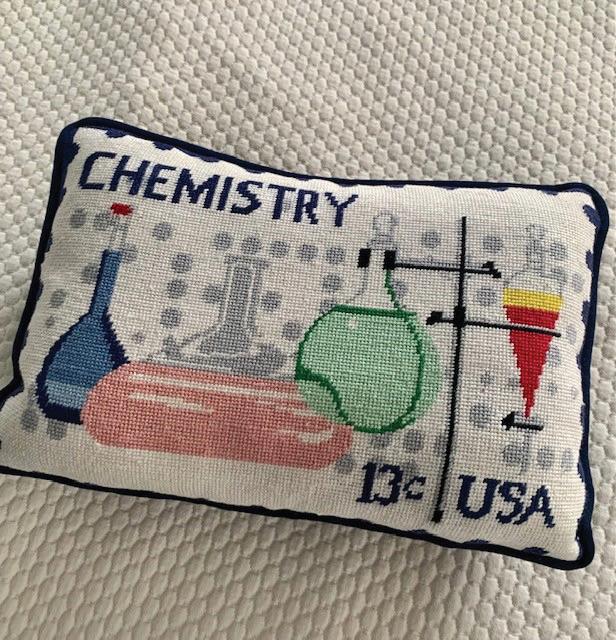
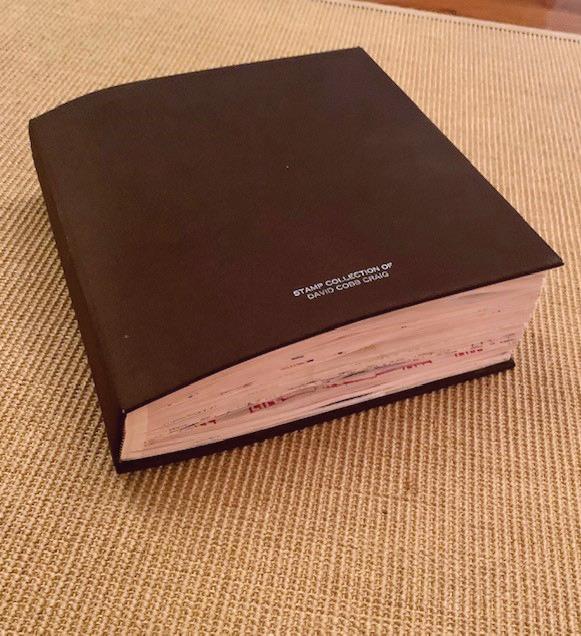
with me and orange, I wonder.
Stamps of the 1960s and ’70s were popular not just with me, but so much so that a company called Everlume put out a ton of needlepoint canvases showing them, including this one from 1976 that I recently completed and made into a pillow (Figure 3).
Over the decades I accumulated stamps I missed out on in my yesteryouth as well as new stamps as they came out, tipped off to their launchings by the stamp column that regularly ran in the Sunday New York Times.
Though the Macy’s stamp department eventually shuttered, I was able to easily purchase stamps from the dedicated philatelic windows at New York post offices, particularly Grand Central, Rockefeller Center and the granddaddy of them all, the James A. Farley Post Office, the largest in the country and then open 24 hours.

In contrast to a lot of philatelists, my collection contains only full panes, and they are lovingly preserved in four thick albums (Figure 4).
About 10 years ago in my apartment on Manhattan’s Upper West Side, I showed one of those albums to my photographer friend, David Hamsley. “Gee, you know what,” he exclaimed. “I think there’s the makings of a book out of these stamps.”
David proposed photographing them digitally in extreme detail — five or 10 times their size — so that the printing and graphic intricacies were exposed with Hubble clarity. As he set about capturing images, I started to educate myself more about them.
Turns out, while I was coming of age in the middle of the 20th century, so were our country’s stamps. Thanks to the advocacy of the Citizens’ Stamp Advisory Committee,
which was formed in 1957 (a year before I was born), the look of American stamps began to move beyond the monochromatic busts of presidents, statesmen and Founding Fathers (the so-called deadheads) who had decorated stamps for nearly a century.
After acquiring the latest in printing technology in the form of Giori presses, the postal service commenced turning out multicolor stamps. Whirring off a Giori in 1957 was the first stamp to illustrate Old Glory in the full splendor of red, white and blue — and it also happens to be the first stamp illustrated in First Class, on page 7. Following it are 121 other stamps, the last a Christmas stamp from 1977, basically covering the period of my infancy to the end of my teens.
Almost all of those shown are commemorative stamps, but there are also a couple of airmail stamps and definitives. One of the latter is a 1963 stamp designed by Robert T. Jones showing the Stars and Stripes rippling above the White House and bearing only the denomination as “5c,” one of a smattering of American stamps that makes no note that the U.S. issued it. (This was also a surprise to learn.)
All of the stamps in the book are in the public domain and did not require any special permission from the U.S. Postal Service to reproduce, but there were a few stamps that had to be dropped because the USPS wanted a licensing fee, including — very disappointingly — a stamp by the great industrial


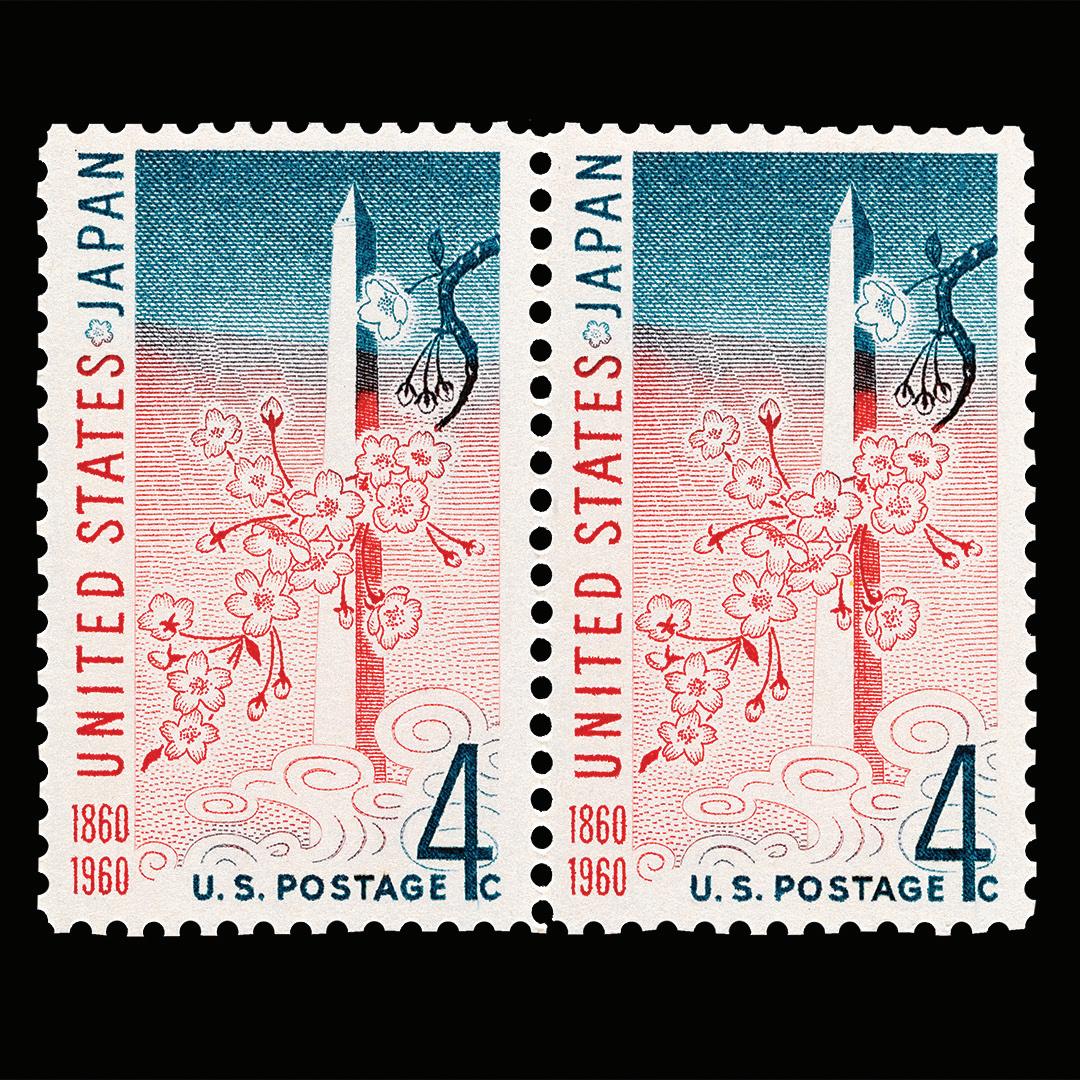


artist Raymond Loewy to gong the new USPS logo that made its bow in 1971 (Figure 5).
Loewy was just one of the many top talents to design stamps in the period my book covers. Another was Georg Olden, the first African American to design a stamp, one hailing the centennial of the Emancipation Proclamation in 1963 (Figure 6).
Four years later, Olden perked up envelopes with a snappy design for Voice of


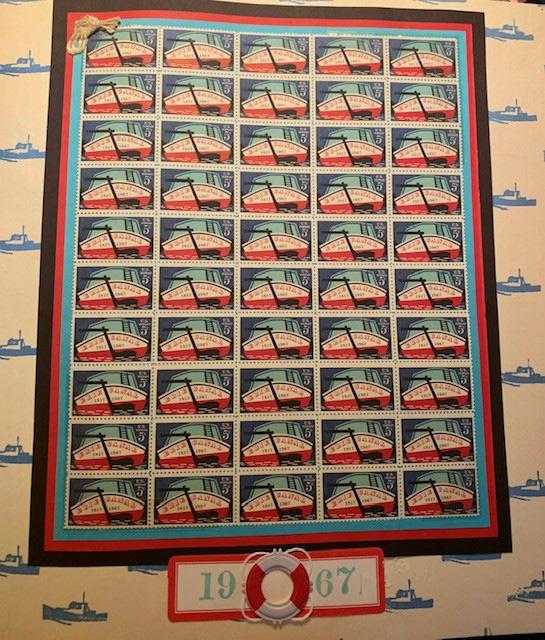
America. Both stamps are represented in my new book, and they are my favorites, as they evidence very simple and guileless designs (a broken chain on one, an antenna on the other) that bespeak the very essence of clean, unadorned modernity.
Gyo Fujikama also produced similar orb-enthralling imagery that is limelighted in the book. A Japanese-American commercial artist who barely avoided intern-
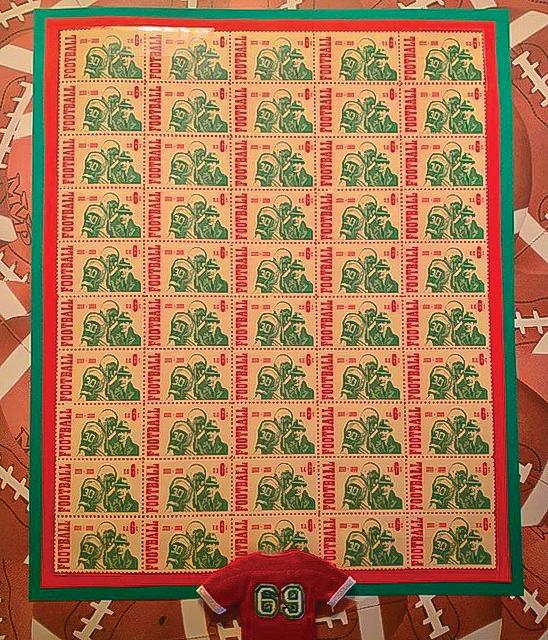
ment in Arkansas during World War II, Fujikama was the earliest mainstream illustrator of picture books to include children of many races.
In 1960, she confected a lovely pink and baby blue stamp to mark 100 years since the U.S. and Japan signed their first treaty to foster goodwill, and it illustrates the Washington Monument behind a scrim of cherry blossoms (Figure 7). The same
flowers frill Fujikama’s 1966 5-cent Plant for a More Beautiful America stamp which helped tout First Lady Bird Johnson’s campaign to Keep America Beautiful.
Prior to the 1960s, most U.S. stamps were designed anonymously, but not to say unimpressively by master engravers at the Bureau of Engraving and Printing in D.C. I was not a little amazed (and proud) to discover that the post office was making an effort six decades ago to diversify its roster of designers with women and people of color like Olgen and Fujikama. Finding out about them (and all the other designers) required a lot of clawing around on the internet to come with enough snippets here and there

to build the snack-size text blocks that go with the book’s large-scale photos.
By 2015, the research was completed. Over the next few years, David and I knocked on many doors before Schiffer, a Pennsylvania publisher, said yes to our 176-page book. But with supply-chain issues, it was not until December 6, 2022, that the book finally came out. There have been many gratifying aspects to having written First Class (book signings, good reviews, composing this article), but the most satisfying was donating a copy of it to my hometown library in Oak Grove, located just a block from the post office where it all started.


Born and reared in Louisiana, David Cobb Craig miraculously landed a job as a reporter at Life magazine not long after graduating from New York University with a degree in cinema studies. In 1990, he moved west to work in the Hollywood bureau of People magazine. Since 2013 he has been employed by Food Network Magazine in New York City. Besides stamps, David also collects book plates, vintage needle kits, advertising lenticulars, 1960s and ’70s postcards of malls and other small things that don’t take up much room in his apartment on Manhattan’s Upper West Side.
We encourage readers to send their comments, questions and feedback to the Philatelic Literature Review. Your feedback, questions, concerns and suggestions help us to improve the journal.
Submission of a letter implies consent to publish, unless specifically prohibited by the sender. The decision of whether to publish is made by the editorial staff of the Philatelic Literature Review.
Generally, letters will be published unless determined to be offensive, disrespectful, libelous, slanderous or not chiefly related to the stamp hobby.
The opinions expressed in a Letter to the Editor are those of the author and not the Philatelic Literature Review or APRL. We do not publish or accept requests for the publication of anonymous letters.
To allow more Letters to the Editor, you are respectfully requested to limit submissions to 500 words or less. If your submission is longer, the editorial team will ask you to resubmit a shorter version, or provide you with a copy of an edited version to review prior to publication.
Submit your letters to plrarticle@stamps.org, subject line “Letter to the Editor” or mail a typewritten copy to Letter to the Editor, The Philatelic Literature Review, 100 Match Factory Place, Bellefonte PA 16823.
In response to [editor Susanna Mills’ query about favorite books] in the Philatelic Literature Review...
I have a couple shelves of philatelic books, non-fiction and fiction, and here are a few of my favorites. I also have foreign language philatelic books in Danish, Polish, Czech, Slovak and German. Here are six of my favorites:
The World of Donald Evans by Willy Eisenhart. Published by Harlan Quest, 1980.
The World Of Donald Evans is about the artistry of Donald Evans who painted stamps by the thousands and in doing so created his own imaginary countries, covers, souvenir sheets and miniature sheets.
The art was “stamp size.” For each country he created a history, a culture, a people, even national products.
Evans was an American from New Jersey. He had exhibits in New York City and the gallery showed the art “stamp size” and reproduced them to 4 inches by 5 inhes to give away to attendees. I have several.
I attended an exhibit in New York (a gallery on 5th avenue across from Tiffany’s) and it was exciting and so imaginative! At the time his

work was selling in the thousands of dollars each.
Evans moved to Holland and unfortunately got caught in an apartment fire and died. He was 28.
Anatolia by Menachim Max Mayo. Self-published, 1990.
Anatolia by Menachim Max Mayo, published in 1990 discusses the stamps of Anatolia -- Ankara Issue, Posta Issue II, Osmanli Issue II, Issue IV, revenues, with more than 300 pages of descriptions and illustrations.
I was collecting these stamps at the time and this was the most complete text I had found on the issues. We spoke once in the 1990s and he was full of all sorts of information.
Mayo wrote a page of poetry to Mustafe Kemal Ataturk and included a full size photo.
Included with the book is a separate softback Concordance & Inventory listing abbreviations and catalog numbers from Mayo, Scott, Gibbons, Michel and Pulhan. For example Mayo lists a stamp with his own catalog number and the six other catalogs! And provides space so a collector could keep track of his/her stamps, mint, used, doubles, covers, etc.
Mayo was living at the time in Virginia.
Fleeing From the Fuhrer by Brinson & Kaczynski, 2011.
From The Winged Heels of Mercury. Published by Collectors Club, San Francisco, 1984.
Czeslaw Slania, Master Engraver. Published by Radway Press, New Zealand, 2008.
Czeslaw Slania, The Master and His Work. Published in Germany, 1990, a multipage loose leaf book
Myron S. Kavalgian Old Lyme, Connecticut
If you are a philatelic author seeking assistance with your research, drop us an email (LetterToTheEditor@stamps.org). Include “Author’s Inquiry” in the subject line. Please keep your message to under 100 words. These will be published on a space-available basis and at the discretion of the editorial department.
The Philatelic Literature Review depends on APRL and APS members, who provide much of the content of this journal. We would like to encourage more people to join our roster of philatelic writers for the Philatelic Literature Review. The journal publishes a wide range of articles, on topics that include the following: how to conduct philatelic research; old and new philatelic literature; archives and library collections; book reviews; writing and research advice; profiles of philatelic figures; the future of philatelic research, and more. If you have an idea for an article or are interested in becoming a regular contributor, please send an email to plrarticle@stamps.org. For information about APS writing guidelines, visit aps.buzz/writeap.
The number of Vooys Fellows has grown rapidly in the last two years, which means greater support of the American Philatelic Research Library.
APS Executive Director Scott English attributes that success to “two reasons: 1. The growth coincides with retirement of the Match Factory mortgage in 2020, [meaning that] supporters are now dedicating contributions to non-debt items like Vooys and digitization, and 2. We asked and our members are responding. We plan to keep asking, so please join us in growing the Fellowship.”
Seven individuals who have begun their pledges to attain Vooys Fellowships are William O’Connor, Van Siegling, Chris Green, Foster Miller, Murray Abramson, Trish Kaufmann and Melanie Rogers.
Pledges recently fulfilled are from Brian J. Birch, Stephen Bonowski, Dr. Jason Hewitt Manchester, Greg Galletti and Dr. Kenneth Grant.
The Vooys Fellowship, named after Daniel W. Vooys, was established in 2007 to recognize those who have supported the APRL and its missions with a donation of $5,000, given over a period of five years. Vooys (1918-1978) himself helped found the American Philatelic Research Library and began publication of this journal.
Vooys Fellow privileges include: A vote for Founder/Patron representative on APRL Board of Trustees; an opportunity to run for Founder/Patron representative on the APRL Board of Trustees; a lifetime subscription to the Philatelic Literature Review; a personal Vooys Fellow plaque; and their name on a Vooys Fellow plaque in the APRL.
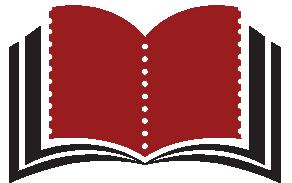
Book reviews are written by PLR readers and contributors. We welcome new authors to write reviews of books (or other resources - articles, journals, monographs, videos and more). Contact Susanna Mills at smills@stamps.org to learn more and discuss parameters, or the PLR editorial team at PLRarticle@stamps.org to submit a book review.
Aerofilatelia, Crociere Atlantiche, Balbo (June 2022; Turin) by Francesco Giaccardi. In Italian, perfect bound (8¼ inches by 11½ inches), 161 pages, color throughout. €39 (approx. $42) plus postage. Available from fgiaccardi@ yahoo.fr.
The author of this interesting book (Figure 1) is an avid collector of the transatlantic mass flights headed by Italo Balbo in 1930 and 1933. The subject matter does not lack ample bibliography, but there is always something new or more elaborate to discover and this monograph fits that scenario.
As Roberto Gallo points out in his preface, “there remains the many stories regarding the backstage aspects such as comments, anecdotes and curiosities, as well as the financial aspects regarding the issuance of expensive stamps to make collectors pay the overblown costs of the aerial ventures; in this respect the author carefully and diligently examines all these aspects even though his auditing results may produce pitiless results.”
Giaccardi has articulated his research in 12 chapters, the first of which focuses on the South Atlantic aerial cruises of 1930-1933, Italy to Brazil, from Orbetello to Rio de Janeiro. A specific and informative chart provides lots of details such as

the stages of the flight, both going and returning. The composition of the four squadrons and the number of flown covers are also included.
The commemorative stamp (Figure 2) created for this complex endeavor (Scott C27), we learn, was not officially announced (with an official release date of December 15, 1930), and only in early February 1931, when the whole venture was over, a timid disclosure was made.
Two months later, in his address to the Italian Parliament General Italo Balbo reassured the honorable members that in order to fund the transatlantic mass flight a special stamp was ap-
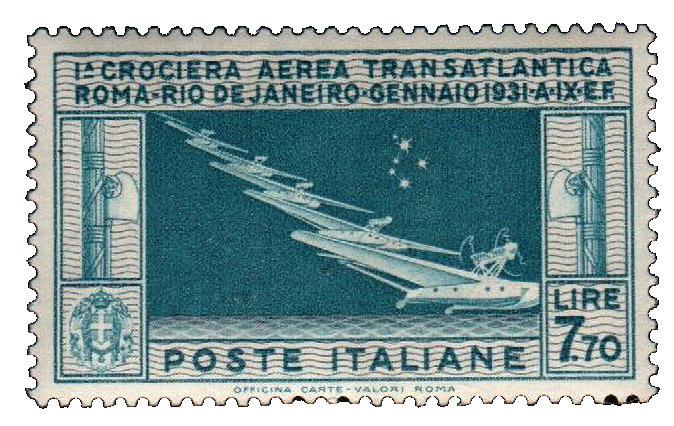
proved and issued by the Ministry of Communications. The proceeds were expected to be more than sufficient to cover the costs of the great enterprise of Rometo-Rio, as well as future ones (Figure 3). This chapter like the other 11 is superbly illustrated and replete with information.
As expected, the chapter on the 1933 North Atlantic cruise (OrbetelloChicago-Rome) is also richly documented. Once more, Balbo planned to finance the parade of Italian grandeur with stamps and philatelic souvenirs. Given his scanty knowledge of the philatelic
market the general could not ignore the strong competition from foreign countries. He enrolled a Roman stamp dealer by the name of Vittorio Lo Bianco to act as consultant; the end result, as we shall see in Chapter 9, was the issuance of an impromptu return flight triptych, which in due course, reached stratospheric prices.
This chapter benefits from very useful illustrations regarding varieties and three charts answering all the questions a reader may ask. When you have read this book you can even lecture on the subject without any fur on the tongue.
The North Atlantic Cruise commanded an expenditure of what would be $9 million today, while revenue for sold stamps amounted to the equivalent of $20 million in today’s money. But this amount did not consider charges of foreign countries to get their share for transit and conveyance of flown covers franked with the mesmerizing triptychs.

The author goes through all of this profit and loss analysis to conclude that such a financial debacle should have unleashed an uproar in Parliament, even from Balbo’s party.
This is the type of research that may not please the philatelic commerce moguls, but it will obviously intrigue the philatelists. At this pace we reach Chapter 8, which delves into forgeries and fakes.
Collectors will certainly welcome chart 5A showing the postal rates to the various destinations. The book ends with a detailed bibliography, photography sources and filmography.
In our days of internet, foreign readers can manage to translate and understand most of what this useful book offers. If you collect this area this book is a “must have”; additionally, it is a pleasure to handle for its illustrations, charts and high quality production.
Reviewed by Giorgio Migliavacca
Enciclopedia dei Castelli d’Italia, La Storia dei Castelli, by Ketty Borgogno, Nicola Luciano Cipriani, Stefano Proserpio. Hardbound (8¼ inches by 12 inches), Vol. 0, The History, 104 pages; and Vol. 1; 232 pages, La Serie. Color illustrations throughout. €40 (approx. $43) for Vol. 1 [Vol. 0 at no cost] plus postage. (Bank wire transfer accepted). Available from enciclopediacastelli@gmail.com.
Since the early 1970s, definitive series have become very popular with collectors of Italy for many reasons, including the ease of finding basic material and stamps to lay the foundation of the collection as well as paying attention to any development regarding the tariffs, varieties, frankings of special interest, forger-


ies to defraud the post office, change of currency, combination frankings, paper and watermark varieties, as well as perforations, gum and ink types and nuances.
The Castles definitive has enjoyed popularity in Italy and abroad. The reason for this is the possibility of retrieving mail sent to foreign countries as well as domestic mail and specialist items to give in exchange to foreign collectors. When you find stamp collectors on Facebook you will easily notice that they have friends and contacts all over the world. That’s called collectors fun.
The co-authors of this specialized encyclopedia have great enthusiasm and great plans. To begin with, their project is expected to have an additional five or six volumes. This is possible because of the large number of articles published in Italy and the collaboration of enthusiastic collectors. The authors themselves have written extensively about this definitive and have been able to build remarkable collections.
Some 52 stamps have been issued for the Castles definitive, the fifth definitive of the Italian Republic. Some 27 stamps were issued initially (Scott 1408-1434) and by popular demand some 25 additional castles (Scott 1475-1484; 16571666; 1862-1866) were welcomed by collectors. The historic importance of these castles is a great catalyst for both collectors and history enthusiasts.
The definitives that preceded were the Democratica, Italy at Work, the Siracusana, and the Michelagiolesca, the first three redundant with rhetoric aimed at reunifying the population and restoring democracy, peace and brotherhood. The Michelangiolesca restored the Italian pride stemming from great artistry and endless talent of Italian geniuses. What
was missing in some form was something to make grassroots even more proud of their native land, region, district and town. This was certainly achieved by the Castles definitive: in simple words it awoke civic awareness and pride.
On the practical side we must join the authors when they state that the 52 stamps responded to the demand of specific denominations that were needed to cover the tariffs of as many services provided by the postal service.
The siblings generated by this definitive include stamps for vending machines, postal cards, lettercards, and a special postal card for the national stamp exhibition, Cosenza 1986.
Volume 0 of this encyclopedia includes a detailed profile of each castle featured in this series.
Volume 1 gets down to the basics as it examines the various phases and aspects ranging from the issued stamps, the artwork created for each stamp, the engravers, the printing proofs, die proofs, color proofs, the subject, postal stationery (official and privately issued), the ministerial decrees, the ministerial bulletins, maximum cards, first day covers, first day postmarks, special events postmarks, cinderellas, cards, strange and odd items.
The three courageous musketeers working on this encyclopedia have certainly enthused both the veterans and newcomers. The bibliography is so vast that you will find most answers to your questions.
My review of Danilo Bogoni’s monograph published in 1999 by the Ministry of the Posts is one of the most read entries of mine on Academia.edu. This new encyclopedia will certainly fuel great interest. These two volumes will whet your appetite for the upcoming volumes.
In concluding I must praise the choice of the authors in placing the contents page at the beginning of the volumes which are a pleasure to handle, being very well produced on high-quality paper.
Reviewed by Giorgio Migliavacca
Democratica: L’Ordinaria che Cavalcò i Marosi – La Serie Più Bella del Periodo Postbellico: Corrispondenze e Servizi per L’Estero (2022; Cutrofiano), (The Democratic Definitive
Years: Mail and Tariffs to Foreign Destinations). Perfect bound (8¼ inches by 11¾ inches), 367 pages, color throughout. €49 (approx. $53), plus postage. Available from dr.giannivitale@gmail.com.
If there ever was an attentiongetting cover for a book entirely devoted to Italian postal history, this is the most captivating one. It reminds me of the reverse of the Taranto didrachm issued in the 270s BC and depicting a young man riding a dolphin. However, in this case, Milo Manara’s painting depicts the personification of the Democratic definitive series that witnessed the challenging postwar years from the mid1940s to October 1950. After December 31, 1948 increases in rates caused the invalidation of all the centesimi denominations except the 50 and 80 cents. A similar fate affected the 1.20 lire that had been used in 1945-46 to frank postcards. The rest of the Democratic series remained valid until the end of 1952.
In his preface to this book, expert Gianni Carraro noted that “browsing through this new volume, which is an in-depth research of the use of the Democratic series mail to foreign destinations, I have confirmed the accuracy and attention to details that had typified the earlier volume which delved into mail and ancillary services for domestic mail. Gianni continues to show us his magnificent collection, displayed and described in a personable and pleasant way, replete with important and rare items; these pages exude, once again, his great passion for historical research and postal history.”
The author’s introduction focuses on the postwar diaspora of Italian emigrants moving to the Americas and most European countries. These countries offered new horizons and new hopes to
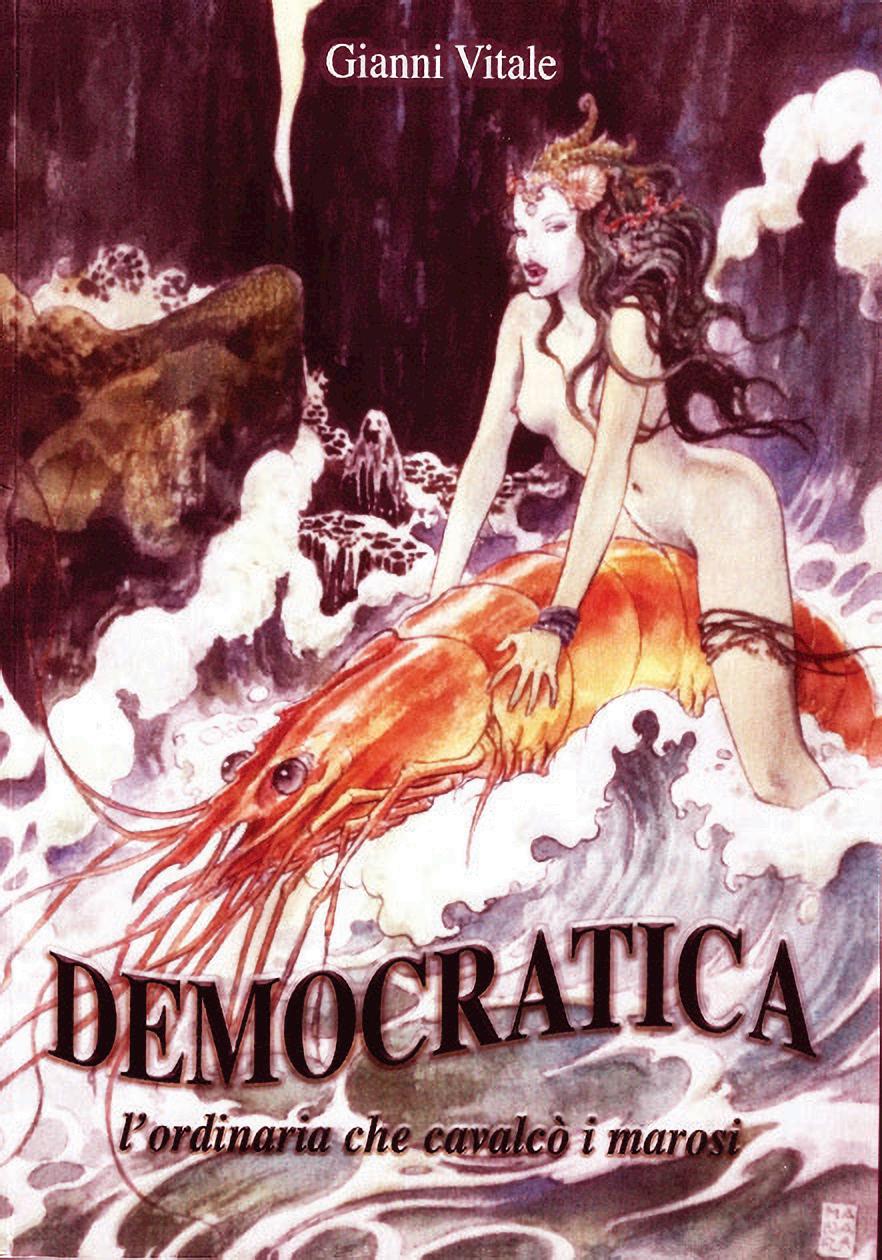
Italian expatriates and facilitated incoming and outgoing airmail, in some countries as early as 1945-1946.
The surviving covers and cards sent to foreign destinations that are the main focus of this monograph are a moving witness of the Italian global diaspora and its struggle to revive the Italian economy with their remittances to family members back home. The figures are heartbreaking, but at the same time they reveal the hopes and determination of those most affected by the tragic turns of fortune.
As for the first book by Vitale, a lengthy series of articles of his were first divulged via Roberto Monticini’s popular website il Postalista (https://www.ilpostalista.it/), which had the advantage of creating new collectors while providing useful feedback from other collectors.
As the “covers to foreign destinations have always fascinated specialists for their intriguing and seductive connotations producing often unusual frankings requiring many stamps ... not to mention the mysterious destinations which by now include dead countries.”
Among the rewards of endless research we learn from this book that among the French initiatives to attract Italian immigrants initially had mixed reactions as we find a postal convention between Italy and France. Effective from June 1, 1950, letters from Italy to France not exceeding 100 grams would pay the Italian tariff with no extra costs to reach French destinations; the same applied to postcards. Needless to say, in due course other European countries followed suit and signed similar agreements.
A specific chapter delves into the mixed frankings including Democratica and Italy at Work stamps; also, much coveted by specialists is mail conveyed by
diplomatic bag.
The various chapters include table charts listing the tariffs for the various types of mail from 1945 to 1951. These will prove very useful to the collector and it will give a good idea of what is difficult to find without entering the quicksand territory of market evaluations.
Very informative chapters conclude this “must have” book. These are about diplomatic bag mail; the 100-lire forgeries of the 100 lire nicknamed, “Buenos Aires forgeries”; the UNRRA camps for displaced persons and related mail.
If you thought that postwar Italian covers and mail has little to offer this book is for you.
Reviewed by Giorgio MigliavaccaSeuchen und Handel – Epidemie e Commercio. Various authors, Bolzano, November 2022. In Italian and German, paperback, 8¼ inches by 10½ inches (27 centimeters by 20cm), 151 pages, full color. €15 plus postage (approx. $16.50 U.S.). For orders contact Dr. Elisabetta.Carnielli@handelskammer. bz.it.
This volume is Notebook No. 12 of the Bolzano (Italy) Mercantile Museum in collaboration with the local Chamber of Commerce. Its main purpose is to explore the various aspects presented by the splendid exhibition “Epidemics and Commerce,” which was inaugurated on November 16, 2022 and will remain open until September 9.
The curator of the exhibition is Helmut Rizzolli, who is valiantly assisted by the brilliant collaboration of Dr. Elisabetta Carnielli.
Visitors will notice that the horrendous advent of the plague and subsequent pandemics spurred the authorities of Bolzano to try their hand at limiting the consequences on the population and on local and transalpine travelers and traders whose contribution to the local economy was decidedly appreciable in the 16th century.
In fact, Leandro Alberti in his Description of All Italy (originally published 1550) confirms that “one of the main characteristics of the city … was precisely that of being the crossroads of traders from most of Europe.” [Bolzano is the capital city of the province of South Tyrol in northern Italy and has a current population of 108,245.]
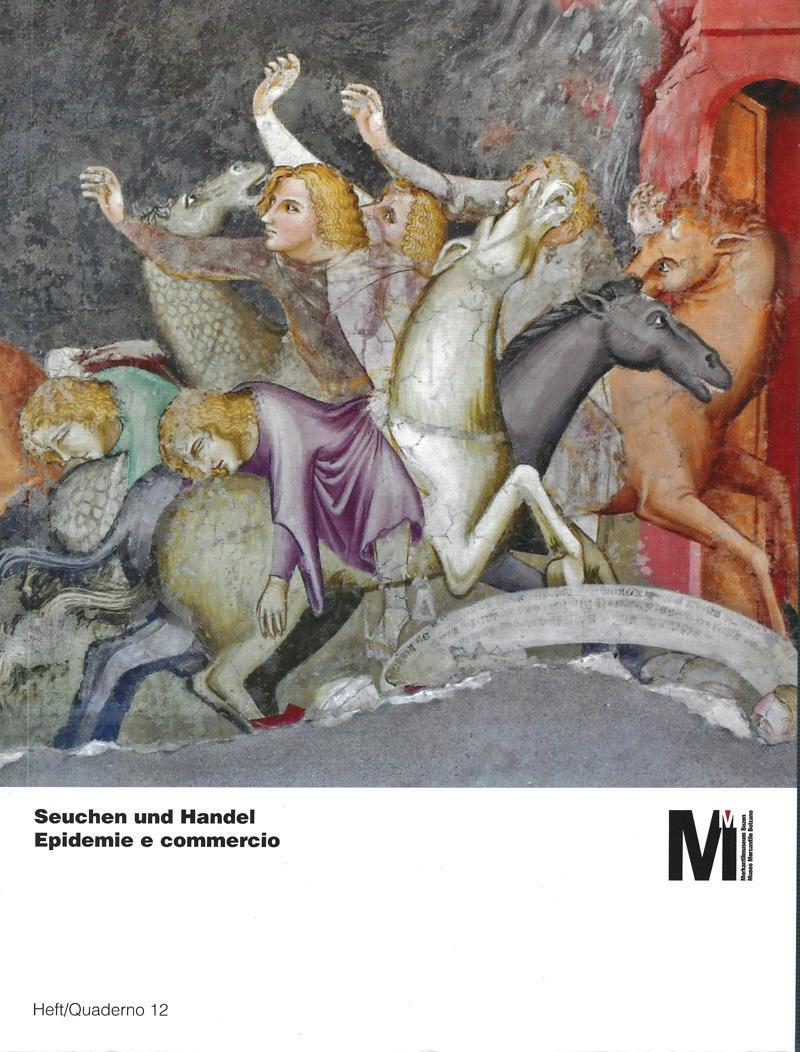
Bolzano had gradually achieved this notoriety starting from the dawn of the second millennium, so much so that in the 13th century we find evidence of Bolzano’s fame as a focal point for setting up regular international fairs. For such a development, a suitable and well-articulated legal regulation through statutes was needed as well as the granting of special benefits and advantages.
These coveted concessions were granted by the princes of the house of Habsburg. In 1635 the Archduchess Claudia de’ Medici, at the time regent of Tyrol, bestowed a mercantile privilege by establishing the new Bolzano Fair. In 1633, Claudia established the mercantile magistrate of Bolzano, which later found a place in the mercantile palace. After some tune up, in 1635, the mercantile privilege or regulation was published with a bilingual text also because Italian was the lingua franca for
European trade.
For his part, historian Claudio Marsilio seems to suggest that the failure of the Verona fairs could be partly attributable to the currency exchange deals held in Bolzano; moreover, according to the admission of the same author, Bolzano’s efforts were concentrated on the importation of goods that enjoyed solid demand in the major cities.
Michl Ebner, president of the Chamber of Commerce of Bolzano, points out that “the exhibition and the accompanying catalog focus on the close relationship between trade and epidemics of the past.”
Maurizio Rippa Bonati guides us into the world of travel and the related health risks for travelers, “yesterday as today, there were diseases that caused particular concern far away from what we can generically define ‘home’ ...”
The author introduces the reader to a vast and exhaustive literature on travel, in-
cluding postal guides, among which those of Ottavio Codogno stand out; among other things he observes that “until now less attention has been paid to the movements of merchants, often protagonists of a periodically repeated commute, which could be defined with a neologism such as peregrinatio oeconomica. ”
This important essay by Rippa Bonati provides unexpected details even for those who have done research and studies on the effects of epidemics on commerce and travelers, including those of historical and literary standing. “Still Montaigne, having arrived in the Po Valley, observes that ‘without bills of health we received in Trento and confirmed in Rovereto we would never have entered the city [Verona]’ .”
The catalog of this exhibition also introduces us to the Venetian theriaca, an ancient drug with unlimited powers with its 63 ingredients, including viper meat and opium. This remedy and its effects are examined by the scholar Eugenio Ragazzi: Its preparation “was permitted only in authorized pharmacies ... through a public ceremony.” The essay concludes with eight pages devoted to the components of theriaca according to ancient recipes.
Postal history pops out with a 13-page essay dedicated to post and epidemics written by the top brass of the Italian Academy of Philately and Postal History, Thomas Mathà, and the author of this review.
In the 18th century, a decline in the incidence of the Black Death began to be noticed, and attributed “to the tenacity of the Italian health authorities and by extension to the preventive, methodical and effective measures adopted by an Austria even more on the alert
due to its trade with the Levant and the its extensive borders with the Ottoman Empire.”
The disinfection of mail was introduced in the Papal States in the mid16th century. During the first decades of the 18th century Ludovico Antonio Muratori expressed skepticism about the effectiveness of the procedure. “The disinfection of mail using fumigations and vapors produced by various substances was called ‘perfuming’

... Another methodology for internally disinfecting the letters was to make cuts or holes that allowed the inner sheets to be fumigated without breaking the seals of the epistles.”
Helmutt Rizzolli offers us a 360-degree overview on facets of the main themes. “Trade routes, routes of contagion and the impact of the plague on Bolzano and its territory.” The presentation is divided into various perspectives, including population growth and foundation of the city before 1350; globalization and the Black Death in the 14th century; the Black Death in Bolzano; epidemic diseases before 1580; health passes, such as the modern Green Passes, which were systematically used for goods, people and livestock; and a collection of 63 health records as a valuable source for economic history.
This is followed by a brilliant essay by Simona Nardi on art in the times of the plague. It is a detailed examination through examples of local sacred art from the Middle Ages to the mid-17th century. The 14th-century fresco by the first Dominican master prophetically titled “The Triumph of Death” has a remarkable visual impact and it is easy to understand the motive that destined it to the cover of this fascinating and elegant volume.
We are still a few months away from the closure of this fascinating exhibition and visitors can witness of the splendid work carried out by the organizers of this cultural initiative of considerable importance especially in our post-Covid era. A related announcement reminds us of a symposium to be held on July 25 at the Mercantile Museum of Bolzano.
Reviewed by Giorgio Migliavacca
American Aid for German War Prisoners: A Postal History, by Harold Joseph Krische. 92 pages, card covers, perfect bound, 8½ by 11 inches, Military Postal History Society, 2023.
ISBN 979-9-9877869-0-1, $30 postpaid in USA or $10 for digital copy from Louis Fiset – lfiset@outlook. com.
Author Harold Krische perused Canadian World War II prisoner of war mail in his own collection as well as those of others, and discovered that many pieces were addressed to Emil Auer, American Aid to German War Prisoners, 16 Duerstein St., Buffalo, N.Y. He learned that Auer was a stamp dealer and a member of the American Stamp Dealers Association as well as the American Philatelic Society.
With the declaration of war, resident “enemy” aliens were relocated to POW camps in Canada. As the war progressed, thousands of combatants were sent to the camps as well. Auer, who was born in Munich, came to the United States in 1925 and settled in Buffalo, where he was soon recognized as being friendly to the German-speaking community. When WW II was underway, he petitioned the U.S. Department of State to establish a war relief organization. Incoming mail to Auer was normally on preprinted forms as postal stationery cards or letter sheets.
As author Krische examined collections of this mail he prepared a census of the types of forms, the origins, and the dates of the mail pieces. Soon, when word of Auer’s efforts spread, German American communities donated goods and funds to support his mailing of par-

cels to the Canadian camps. By the end of 1941 more than 20 additional “chapters” of the American Aid to War Prisoners were established in other states.
The author shows examples of Canadian POW and internee mail with handstamp markings and censorship
devices. Another chapter describes the Jamaican POW and internee mail sent to and from the Buffalo address. This resulted from a camp established near Kingston where Italians, Germans and Austrians were interned. Krische carried out a census of the Jamaican POW mail, similar to that done for Canada, and illustrates many examples. American Aid parcel requests were also permitted from Australia, New Zealand, Bermuda and elsewhere.
Auer’s efforts on behalf of detainees were recognized by the YMCA and the American Red Cross.
The book concludes with an extensive bibliography and an index. Krische has carved an interesting niche in WW II war-related mail, by detailing Auer’s work. This book should be an inspiration to others to seek similar mail and to undertake research in areas not previously explored.
Reviewed by Alan WarrenAugust 9, 8 a.m. – 5 p.m. (lunch on your own)
Instructor: Gary Wayne Loew
Postal cancellations are central to the understanding of the postal artifacts that we collect. This course is designed to provide you with a very thorough background about cancellations. Collectors of every country and every specialization will want to attend this in-depth course. Worldwide examples will broaden your understanding of philately from every continent. You will return home with a robust package of course materials to give you a firm foundation for additional personal research.
Location: Westin Hotel, Cleveland, OH
Cost: $50 for APS members / $100 for non-members
Registration Deadline: July 21, 2023
The PLR publishes information received about new philatelic publications. For inclusion in future issues, send information about recent or upcoming publications to Scott Tiffney at stiffney@stamps.org or to 100 Match Factory Place, Bellefonte, PA 16823. The descriptions of publications listed below are compiled from source material and often are directly taken from these source descriptions.
On Philatelic Writing and Editing
by John M. Hotchner. 8½ inches by 11 inches, 92 pages, perfect bound.
Published by Exhibitors Press, Silver Spring, Maryland, 2023. ISBN: 9798825513195. Available at amazon. com, $19.95.
The author started writing for Linn’s Stamp News in 1976 contributing more than 3,000 philatelic columns in a wide variety of publications since that time. In the series of articles collected here, primarily from the American Philatelic Society Writers’ Unit quarterly, The Philatelic Communicator, the author shares much of the practical wisdom gathered over the years to educate and encourage writers, editors and other philatelists to continue researching and recording philatelic history.
The book has an introduction with a detailed interview of the author, specifically his background and development as a writer. Each of the six chapters of the book includes an introduction with the author’s most recent thoughts on the subject.
While this book is primarily intended for philatelic writers and editors, much of the content applies to all writers regardless of subject.

Postal Cards and Newspaper Wrappers
Used in the Bechuanalands and Botswana: Philatelic Exhibits by Peter Thy. 8½ inches x 11 inches, 184 pages, perfect bound. Published by Exhibitors Press, Silver Spring, Maryland, 2023. ISBN: 979-8389803718. Available at amazon.com, $39 softcover, $46 hardcover.
This resource details postal stationery cards and newspaper wrappers used in the British frontier territories of Bechuanaland in southern Africa. The research is based on two philatelic exhibits by the author, “The Postal

Stationery Cards of the Bechuanalands” and “The Newspaper Wrappers of British Bechuanaland.” This book, however, is far more than two stamp exhibits. It is a treatise on the postal history and political history of these entities as reflected in these postal stationery items issued by a succession of governments.
This book also is the story of newspaper wrappers used at the turn of the century in the British frontier territories of Bechuanaland in southern Africa. Newspaper wrappers were introduced in British Bechuanaland in January 1887 to pay the ½d local and 1d United Kingdom newspaper rates (per 4 ounces). The wrappers were also available in Bechuanaland Protectorate, where they could be used without additional postage from 1892.
The BNAPS Catalogue of Canadian Military Mail Markings Volume 1 –Early Forts to pre-World War 2 by G.
Wayne Schnarr. 8½ inches by 11 inches, 400 pages, softcover, spiral bound. Published by British North American Society, 2023. ISBN: 978-1989280379. Available at Longley Auctions longleyauctions.com, $46 Canadian (approx. $34 U.S.) plus shipping.
This latest work completes the catalog of Canadian military mail markings. Volumes 2 and 3 were compiled and edited by the late C. Douglas Sayles, who also compiled a substantive draft of Volume 1.
Subjects covered include early markings to 1909, militia camp and other military post offices in Canada 1909 to 1941, the WWI Canadian Expeditionary Forces in the United Kingdom, on the European continent in France, Belgium and Germany, and also in Siberia. The final chapter covers WWI internment operations in Canada. Appendix 1 crossreferences Bailey and Toop catalog numbers with the Sayles Volumes 2 and 3 numbers. Appendix 2 lists BNAPS books on military and war-related subjects.

The series builds upon the publications by the late W.J. Bailey and E.R. Toop, including the two-volume Canadian Military Postal Markings (1881-1995) published in 1996 by Charles G. Firby Publications. This catalog combines information from numerous sources, including several BNAPS publications and hundreds of scans of covers and cards from the author’s collection and submitted by BNAPS members.
Red/Carmine, 1¢ Victoria Maple Leaf Issue Advertising Postal Stationery Cards: A Synthesis by Christopher Ellis. 8½ inches by 11 inches, 202 pages, softcover, spiral bound. Published by British North American Society, 2023. ISBN: 978-1989280386. Available at Longley Auctions longleyauctions. com, $45 Canadian (approx. $33 U.S.) plus shipping.
This is the first BNAPS handbook to delve deeply into a specific postal stationery issue, the 1-cent red/carmine Victoria Maple Leaf post card, first issued in 1898, and used until late 1903. A detailed history of the cards includes
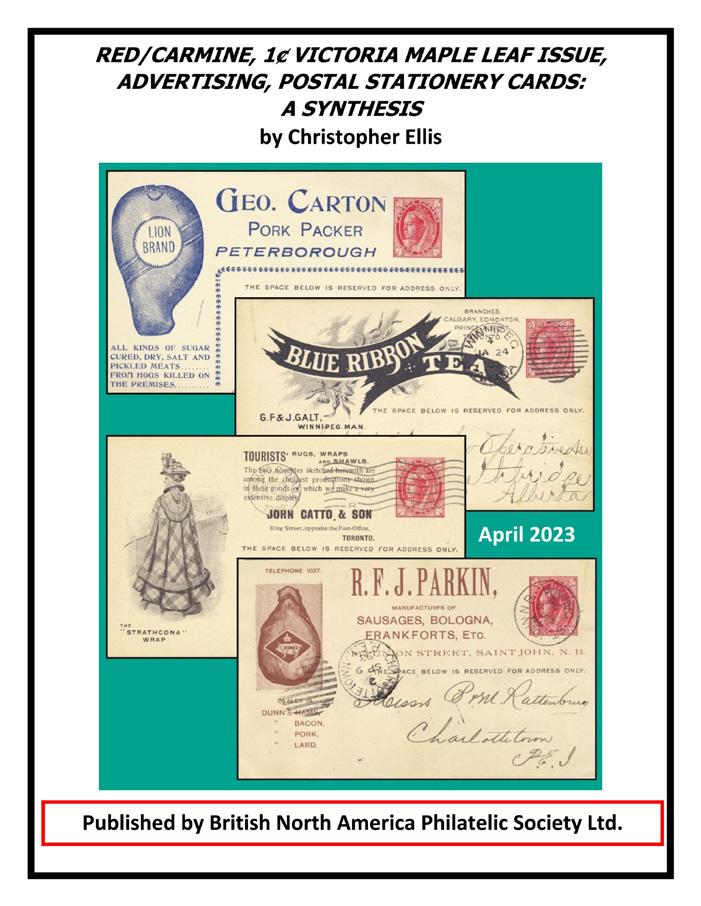
announcements of, and dates of, release; ideas about potentially why they were designed in a certain way; design changes over time; the formats in which they were released to the public; and the postal regulations covering their use.
Profusely illustrated, the hundreds of illustrated cards not only demonstrate postal use but also the many different products and services that they advertised. The result is a snapshot of the social and commercial aspects of the late Victorian era.
Tete-Beche Rarities from the Oval Issue of Finland by Mårten Sundberg and Tomas Bjäringer. 22 cm by 30 cm (8½ inches by 11½ inches), hardcover. Published by Royal Philatelic Society London, 2023. ISBN: 978-1913015213. available at rpsl.org. uk/Publications, £320 non-members (approx. $397 U.S.), £290 members (approx. $360 U.S.) plus shipping. This work documents the rare tetebeches of the oval issue of Finland 1856-

1858, rarities which are highly prized by philatelists the world over. Appreciation of these rarities arose at a relatively late date, but among the former and present owners are many of the most acclaimed collectors in the history of philately.
Each of the 68 recorded tete-beche items is presented with a comprehensive biography including provenance. Four previously unlisted items have been added as well as the story of the items that have been dismissed from previous listings.
One hundred and four owners are presented in short biographies. One chapter deals with collectors who reportedly owned tete-beches, but the relevant individual items could not be identified. Reprints and forgeries of tete-beches are described, as well as reconstructions of large tete-beche blocks. A comprehensive index is also included.
1857-1884 by John Birkett Allan and Alan Green. 8½ inches by 11 inches, 116 pages, softcover. Published by the Malta Study Circle, 2023. Malta Study Paper No. 60, ISBN: 978-1916308527. Available at maltastudycircle.net, members £22.50 or €30 (approx. $28 U.S.), non-members £27.50 or €35 (approx. $34 U.S.) plus shipping.
This book is a comprehensive study of the stamps of Great Britain stamps used in Malta in the mid-to-late 19th century. As well as studying the stamps themselves this book considers how these stamps were used and cancelled.
Chapters include discussions of their early use before the stamps were officially introduced into Malta; the official process for their introduction to Malta; the “M” cancels, along with other datestamps

often used in conjunction with them; the use of British postal stationery during this period; the postal rates from Malta to various destinations including the postal arrangements with the receiving countries; special arrangements for the registration of mail; underpaid and unpaid mail with postage due markings; arrangements for “late letters”; maritime and transit mail; and fakes and forgeries. Malta Post Offices 1806 – 1857 and Their Handstruck Postal Markings by Alan Green. 8½ inches by 11 inches, 100-plus pages, softcover. Published by the Malta Study Circle, 2023. Malta Study Paper No. 59, ISBN: 978-1916308503. Available at maltastudycircle.net, members £15 or €18 (approx. $18.50 U.S.), non-members £20 or €25 (approx. $25 U.S.) plus shipping.
This book reviews the pre-stamp period of Malta’s Post Offices. It integrates information about postal rates, packet

voyages, archival information and relevant study papers to provide the context in which Malta’s hand-struck postal markings were employed between 1806 and 1857.
Divided into four sections, the first illustrates all of the Malta postal markings used by the Packet Office for mail using British Packet services. From June 1843, this also included mail using the French paquebot services.
Postal rates that applied to Malta are summarized with more detail in Appendices. The second section covers the tariffs and postal markings of Malta’s Island Post Office from 1816 to 1849. The next section covers the period from 1849 until 1857. Finally, the last section covers fakes and forgeries. The book also includes color illustrations throughout of the various hand-struck postal markings.
Maritime Mail
Pacific Steam Navigation Company History, Postal History and Stamps of what was once The Largest Steam

Ship Company in the World by Michael J.Y. Roberts. 22 cm by 30 cm (8½ inches by 11½ inches), softcover. Published by Royal Philatelic Society London, 2023. ISBN: 978-1913015206. Available at rpsl.org.uk/Publications, £60 non-members (approx. $75 U.S.), £54 members (approx. $67 U.S.) plus shipping.
The book provides a broad commercial background to this historic steamship company and is intended to appeal to researchers outside the narrower philatelic world. This resource delivers a broader scope by updating all the philatelic and postal history data and applying this to the known examples in each of the relevant categories, whether they be the “VAPOR” marks, the numbered handstamps or the postage stamps themselves.
The author incorporates all the necessary tools for the postal historian to analyze existing and new material, thus a full list of vessels, vessel movement, timetables and postal rates are all included. The additional chapters concerning

the development of company contracts, British Post Offices on the west coast of South America, cargo services and publicity help to give the fullest picture and give the reader some knowledge of the non-philatelic material available to the collector.
Postal Strategies: Logistics, Access, and the Environment edited by Pier Luigi Parcu, Timothy J. Brennan, Victor Glass. 6¼ inches by 9¼ inches, 392 pages, 1st edition, hardcover. Published by Springer, 2023. ISBN: 9783031253614. Available at amazon. com, $180.
This resource includes the original papers of researchers in the field of postal and delivery economics, originally presented at the 30th Conference on Postal and Delivery Economics held in May 2022 in Rimini, Italy.
The central focus of the compilation
are the role of digital platforms in the postal sector and the impact of vertically integrated firms in delivery markets. Other important topics include the regulation of parcels and their environmental footprint, in light of the innovations affecting the so-called last mile, and the effects of the COVID-19 pandemic on the postal sector, on both the global and local levels. Chapters also discuss traditional topics for postal and delivery sectors, including postal costs, the funding of Universal Service Obligation and the related role of Universal Service Providers.
The Postal and Delivery Contribution in Hard Times by Pier Luigi Parcu, Timothy J. Brennan, Victor Glass. 6¼ inches by 9¼ inches, 357 pages, 1st edition, hardcover. Published by Springer, 2023. ISBN: 9783031114120. Available at amazon. com, $180.
This resource includes the original pa-

pers of researchers in the field of postal and delivery economics, originally presented at the 29th Conference on Postal and Delivery Economics held online in September 2021.
The central focus of the compilation is the short- and long-term impact of the Covid-19 pandemic on the sectors, both from the economic and regulatory perspectives. Other important topics include the growth of e-commerce and
the implications for the delivery market; solutions for the “last mile,” and the associated challenges in terms of sustainability.
Chapters also discuss traditional topics for postal and delivery sectors, such as the competitive dynamics in the sector, the business strategies of postal operators, as well as the definition and funding of the Universal Service Obligation.

Huntington Convention Center of Cleveland
Co-hosted by the American Philatelic Society, American Topical Association, and American First Day Cover Society. Sponsored by the United States Postal Service. Featuring 100+ dealers of stamps and covers, hundreds of frames of exhibits and rarities, and can’t-miss seminars and presentations from experts in the hobby. FREE admission.
Visit www.stamps.org/GASS
a specialized library with a collection that is comprised of roughly 90% donated materials, your charitable and thoughtful contributions of literature help the APRL to grow the size and scope of the collection for members and library patrons. This continued growth enables us to maintain the APRL as the world’s largest and most complete worldwide collection of philatelic literature. If interested in donating literature to the library, please contact us at library@stamps.org.
The following individuals and institutions made donations of philatelic literature to the American Philatelic Research Library in the first quarter of 2023 (January-March).
American Helvetia Philatelic Society, S.P. Bansal, William B. Barber, Rick Barrett, Robert M. Benninghoff, Joseph P. Bouffard, Barry Cousins, John K. Cross III, Allison W. Cusick, Paul G. Eckman, Gladys Evan, Thomas A. Frisque, Cheryl R. Ganz, Richard Handler, Keith A. Harmer, John B. Hayhurst, Terence M. Hines, Indiana Postal History Society and Everett M. King Jr.
Also, Ken Lawrence, Bill Longley, Joseph A. Monaco Jr., Gerald E. Noeske, Roland E. Nordberg, Bohdan O. Pauk, James G. Reichman, Ret., Rochester Philatelic Association, Melanie G. Rogers, Robert C. Rudine, Mehrdad Sadri, Vincent A. Sgier, Evan (Van) M. Siegling, Dean Sioras, James C. Solomon, United Postal Stationery Society, Darrel D. Walker and Alan Warren.
What’s YOUR favorite philatelic publication? We invite PLR readers to share their favorites with fellow philatelic literature enthusiasts. The publication can be old or new, common or rare. What is important is that you deem it worthy of inclusion on your bookshelf. Please contact Susanna Mills at 100 Match Factory Place, Bellefonte, PA 16823, by e-mail smills@stamps.org, or by telephone 814-933-3803, ext. 207 with any questions or to submit your essay.
The Clearinghouse lists philatelic literature for sale or wanted by PLR readers. The number at the beginning of each item ‘identifies the prospective seller or buyer. The names and contact information for the sellers and buyers appear at the end of the Clearinghouse. Please write directly to the buyer or seller, not to the APRL, unless the APRL itself is the seller/buyer.
Pricing: The cost for each item is $3 per listing with a maximum of 10 listings per submission. Items selling for greater than $100 are $7 per listing. Please list only one book or periodical title per item; however, several issues of one journal or auction catalog may be listed as one item. PLR reserves the right to reject or edit any listings submitted.
ABBREVIATIONS: HB - hardbound, SB - softbound, PB - paperback, PC - photocopy, LL - loose-leaf, CB - comb bound, CC - card cover, DJ - dust jacket, w/PR- with prices realized, MO - make offer, OBO - or best offer, POR - price on request.
Send Clearinghouse listings to Scott Tiffney, 100 Match Factory Place, Bellefonte, PA 16823; or email Clearinghouse@stamps.org. The deadline for each quarter’s issue is the 15th day of the first month of the quarter: January 15, April 15, July 15, and October 15.
1. Scott Specialized Catalogue of United States Stamps & Covers, by Amos Media. 2020. The bible for U.S. collectors. The last year with yellow page prices by grades. Almost like new, lightly used. SB, 1370 pages. $75
1. Catalog of the 19th Century Stamped Envelopes and Wrappers of the United States by Edmond C. McGovern, Editor. 1984. Detailed description of 19th century PSE designs, errors, and envelope patterns. A very useful reference for classic collectors. HB, 344 pages. $15
1. A Price Guide to U.S. APO Cancels of the Second World War by Jim Forte and Richard W. Helbock. 1966. A thorough listing of APO cancels and detailed explanation of locations and dates. Details on how to use the guide. SB, 135 pages. $40
1. United States Doanes, A Catalog of Doane Cancellations, Revised Second Edition, by Richard W. Helbock and Gary Anderson. 2002. Includes illustration and description of the many Doane cancels. Organized by state. Includes earliest, latest, and scarcity details. A must have reference book for cancellation collectors. Like new. SB, 336 pages. $25
1. African Americans on Stamps by Mark Bernard Morant. 2003. Lists African Americans on stamps around the world with names and descriptions of the persons. Profusely illustrated and useful for this popular topic. HB, 228 pages. $35
1. Cyclopedia of United States Postmarks and Postal History by Delf Norona. 1975. A great reference for a postal historian and cancel collector. Much historical detail and many illustrations and explanations of the many types of cancels used from late 1700s to mid-1930s. Compliments other cancellation references. HB, DJ, 405 pages. $25
1. The Handstamps of Wells, Fargo & Co. 1852 to 1895, by John F. Leutzinger. 1993. Provides detailed dates, locations and the various types of handstamps for this Western U.S. mail distribution system. Very good illustrations of the handstamps. HB, 371 pages. $30
1. The Postal History of the AEF, 1917-1923 Edited by Theo. Van Dam. 1980. A terrific reference for of WW-I postal history of Allied Expeditionary Forces. Illustrated with narrative on postmarks, censor markings, and auxiliary markings of AEF mail. HB, 242 pages. $50
1. Postal History of American POWs: World War II Korea Vietnam by Norman Gruenzner. 1979. Provides a brief history of POW mail and much detail on POW mail to and from various camps for the three wars covered in the title. Cover wear. HB, 138 pages. $20
1. United States Match and Medicine Stamps by Christopher West. 1980. Descriptions and illustrations of 5 main groups, Printings, die varieties, colors, etc. of the tax stamps. One of the best books for this facet of the hobby. HB, DJ, 110 pages (includes plates) $50
2. Postal History of American POWs: World War II, Korea, Vietnam by Norman Gruenzner. 1979, HB, 138 pp., dj, maps, b&w illus., new. $15
2. United States Letter Rates to Foreign Destinations, 1847 to 1876 GPU – UPU by Charles Starnes. 1982, first ed., HB, 74 pp., tables, b&w illus., signed by author, new. $20
2. A Contemporary Account of the First United States Postal Cards 1870-1875 by Charles Fricke. 1977, SB, 146 pp., b&w illus., incl. copies of newspaper clippings, correspondence, official records, patents, like new. $5
2. Los Secretos de las Rutas y Tarifas Aereas en Sudamerica. 1928-1941 (The Secrets of Air Mail Routes and Rates in South America 1928-1941), by Mario Kurchan. 2001, first ed., SB, 192 pp., English & Spanish, tables, maps, b&w illus., new. $20
2. The White Rajahs of Sarawak: A Philatelic & Historical Study by Barry Floyd. 2003, SB, 76 pp., color illustr., like new. $10
2. The Postage Stamps of Switzerland, 1843-1862 by Paul Mirabaud. 1975, HB, dj, 262 pp., b&w plates and illus., like new. $40
2. The Court Fee and Revenue Stamps of the Princely States of India: Vol. II – The Stamped Paper including Second Adhesive Stamp Supplement by Adolph Koeppel. 1989, HB, 331 pp., plus supplement, b&w illus., new. $20
2. Thirty Years of St. Helena, Ascension and Tristan da Cunha Philately by Michael Mueller & Peter McCann. 2006, HB, dj, 193 pp., b&w maps and illus., new. $15
2. St. Helena, Ascension, and Tristan da Cunha Philatelic Society’s 20th Anniversary Anthology by Russell Skavaril. 1997, HB, dj,189 pp., tables, maps, b&w illus., new. $10.
2. Historia Postal Maritima del Rio de la Plata Republica Oriental del Uruguay (River Plate Maritime Postal History Republic of Uruguay) , by Mario Kurchan. 1996, SB, 256 pp., tables, maps, b&w illus., new. $10
1. Gerry Robbins, P.O. Box 89, Bellefonte, PA 16823-0089 – E-mail: gerry.robbins@ cox.net Phone: 703-628-4858. Shipping and handling extra at current rates. Expect mail delays due to USPS issues resulting from COVID-19 issues and their revised delivery policies.
2. American Philatelic Research Library, 100 Match Factory Place, Bellefonte, PA 16823. Phone: 814-933-3803 ext. 240. Email: library@stamps.org. Shipping extra.
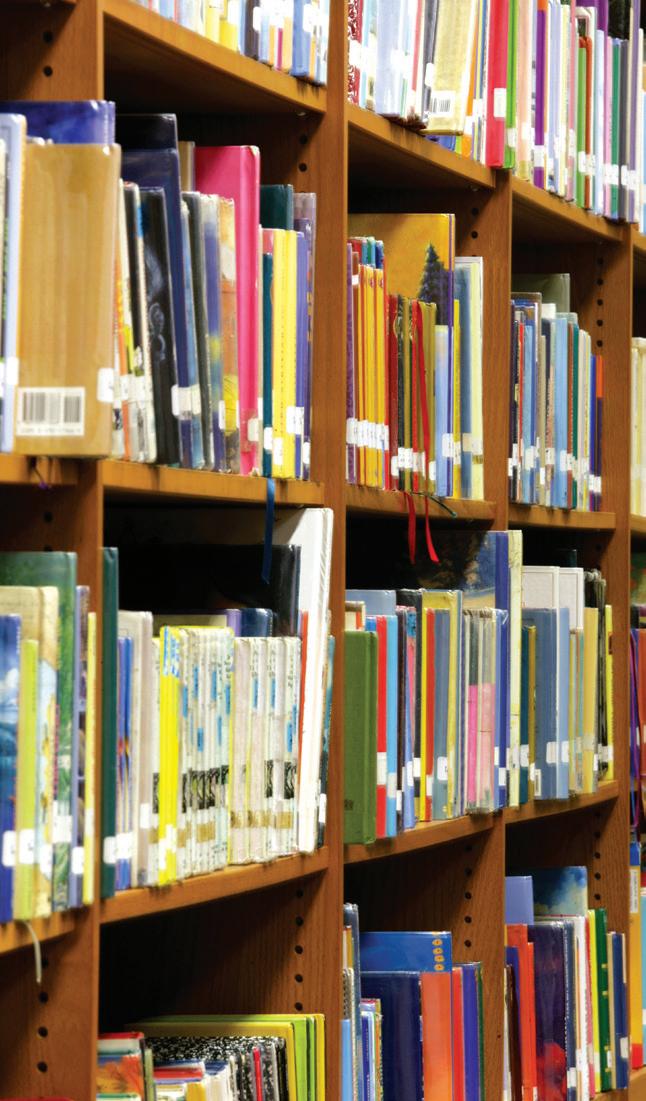
The APRL welcomes donations of philatelic literature and materials (please include an itemized list) as well as monetary contributions to secure the growth and maintenance of library services. Two specific APRL funds need your financial support. Contributions to the Building Fund are used to pay for the physical plant that houses both the APS and the library. Donations to the Acquisitions Funds are used to purchase additional resource material, whether new or used, for the library. Please send your inquiries to Scott Tiffney at stiffney@stamps.org.

The APRL is the world’s largest — and most accessible — philatelic research library, with over 90,000 volumes and special collections housed in a state-of-the-art facility in Bellefonte, Pennsylvania.
The collection includes books, journals, auction catalogs, government documents, price lists, new issue announcements, show programs, copies of exhibits, and more. The collection’s coverage is worldwide and the library collects material in any language.
The library is open to the public and accessible around the world via reference, photocopying, and scanning services, and a growing online collection. Normal operating hours are Monday through Friday from 8:30 a.m. to 5 p.m. Eastern time. Visitors are welcome.
Subscriptions to the library’s quarterly journal, the Philatelic Literature Review, include associate membership in the APRL. Members of the American Philatelic Society are full members of the APRL.
Library fees help to offset the cost of providing services. There is no charge for the initial consultation and we will send you an itemized bill for fees when services are provided. Additional donations are welcome.
Full members (North American addresses only) may borrow books directly from the library.
Base fee: $10 per shipment (includes up to 15 minutes of staff time)
First book: $5
Additional books (up to 5 per shipment): $1
Photocopies or scans with a book loan: $.25 per page
$10 ($15 for non-members) includes up to 15 pages and 15 minutes of staff time; $.25 per page for additional pages.
$5 ($10 for non-members) for the first page; $.25 per page for additional pages.
After 15 minutes of staff time, research assistance is billed at $20 per hour in halfhour increments.
Members can access the APRL’s growing digital collection. Download, print and fulltext search journal issues, books, exhibits, maps, and digitized archival material.
Search the library’s catalog and explore our collections at stamplibrary.org. To request book loans, photocopies, scans, or research assistance: library@stamps.org • 814-9333803 (press option 4)
APS No.
Name
Address
City ________________________________________________________________ State _____________
Recommend the PLR to your fellow researchers!
E-mail: _______________________________
ZIP/Postal Code _____________
Country _____________
• Comprehensive philatelic bibliographies
Canada
U.S.
Other or online only
$33
$42
$62
$26
$35
$21
$30
$50 $55
Type
Subscription/Membership
Philatelic Literature Review Subscription
• Indexes to other stamp periodicals
Library Sustaining Membership (includes PLR subscription)
Library Contributing Membership (includes PLR subscription)
Ages 18–39
$600 Ages 40–54
$500 Ages 55–64
$430 Ages 65+
Library Life Membership (includes life PLR subscription)
• In-depth reviews of current books & catalogs
$360 Library Patron (includes life PLR subscription)
$1,000
$5,000
Daniel W. Vooys Fellow (includes life PLR subscription)
• Philatelic Literature Clearinghouse and more!
Check box and mail with remittance to: APRL, 100 Match Factory Place, Bellefonte, PA 16823
Check Payable to APRL Visa/MasterCard/Discover
Payment:
__ __ __ Exp. Date __ __ • __ __ Verification Code __ __
Account No. __ __ __ __ • __ __ __ __ • __ __ __ __ •
Payments for PLR subscriptions/ APRL memberships in excess of the basic subscription may be tax deductible.
Date
Signature on Card
ISSN 0270-1707
American Philatelic Research Library 100 Match Factory Place Bellefonte, PA 16823
Second Quarter 2023
Name
APS No.
Second Quarter 2023
To change your subscription information, fill out this form: